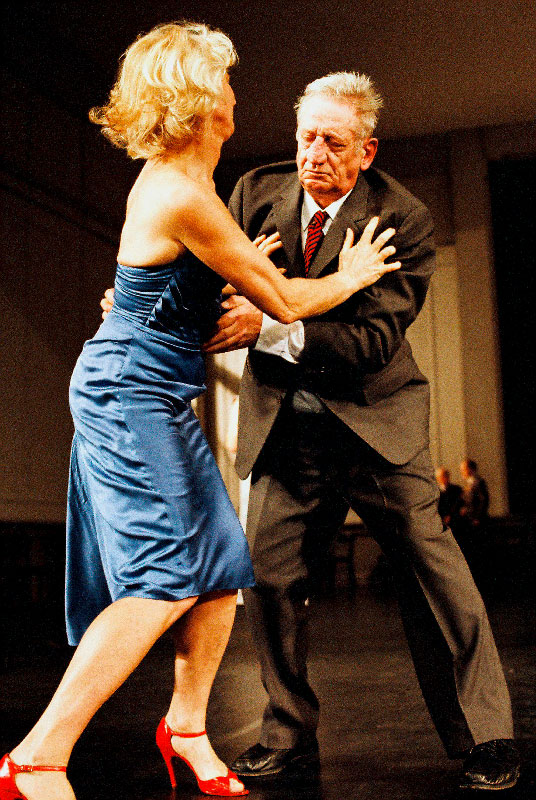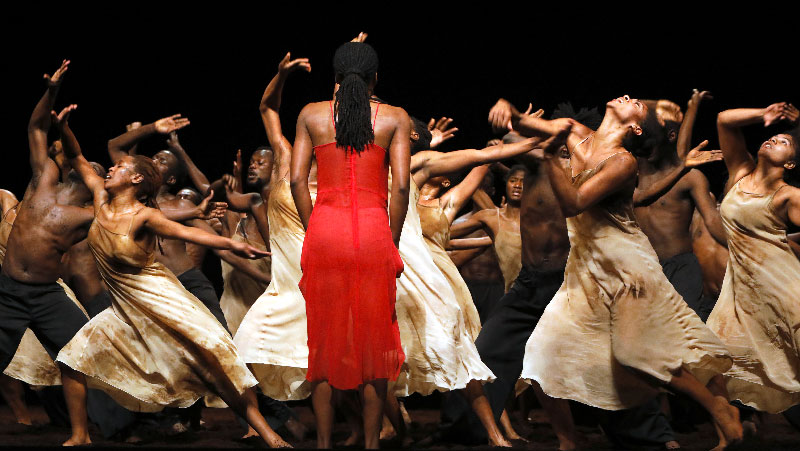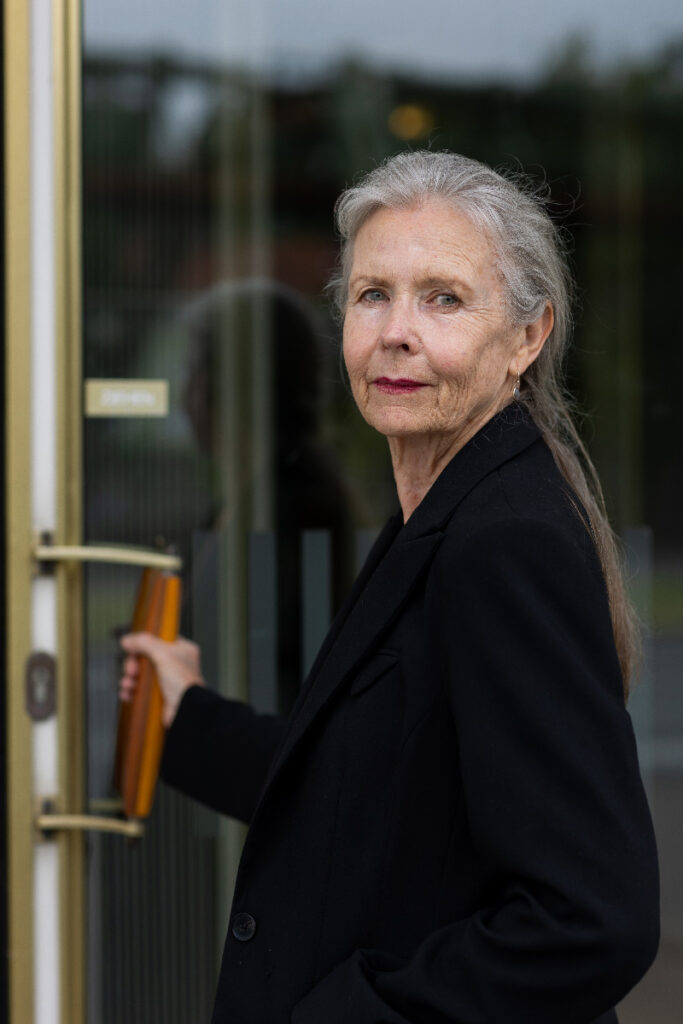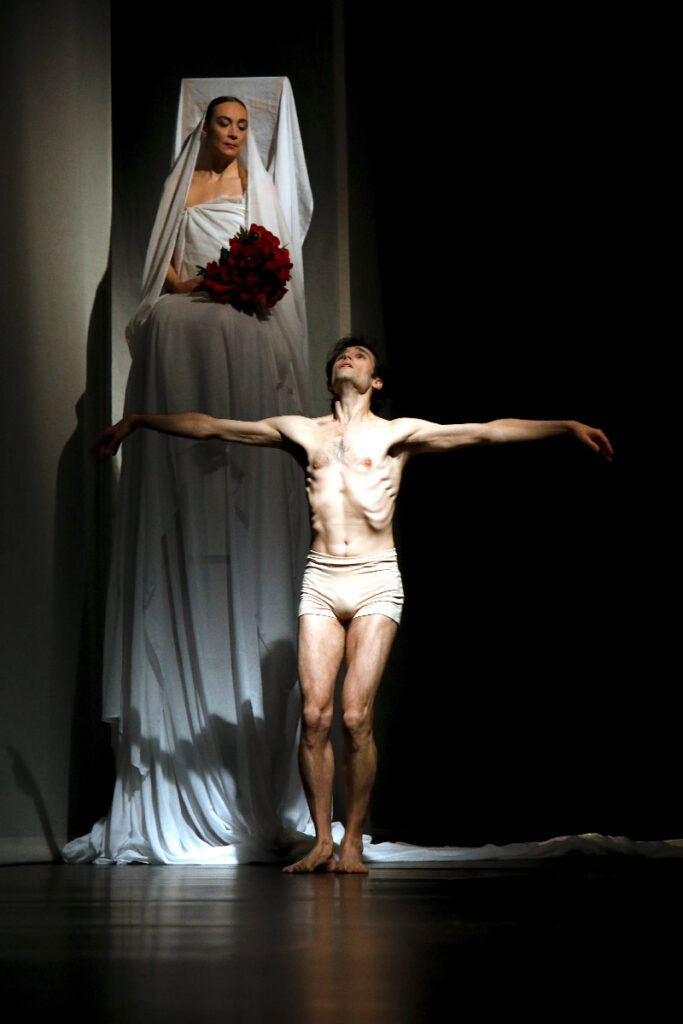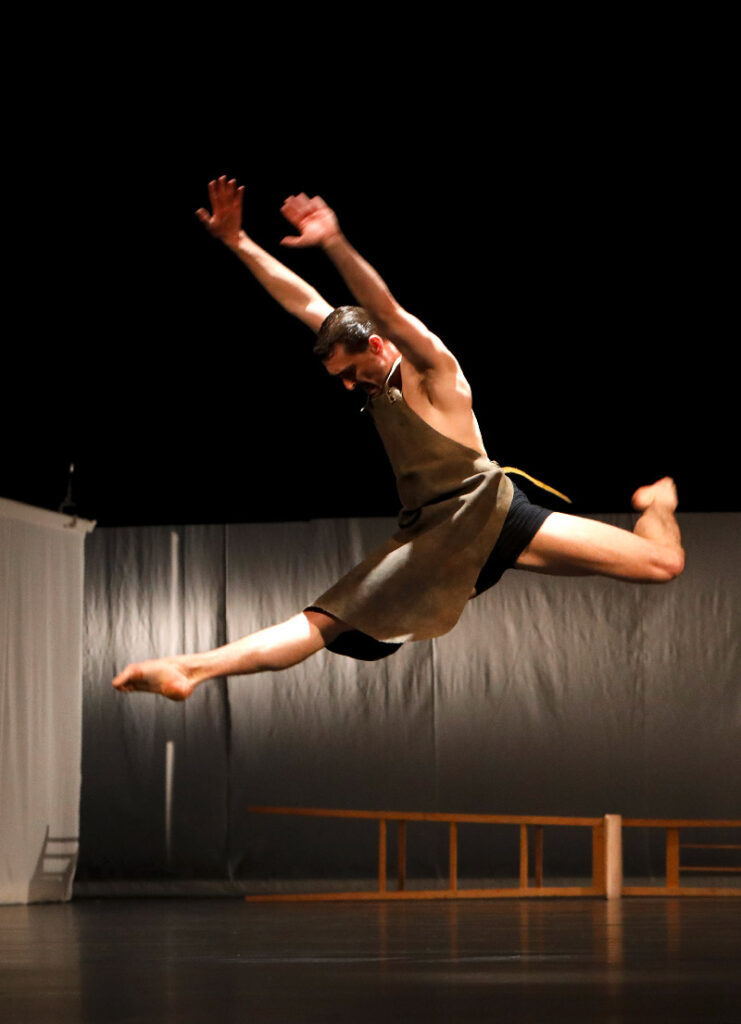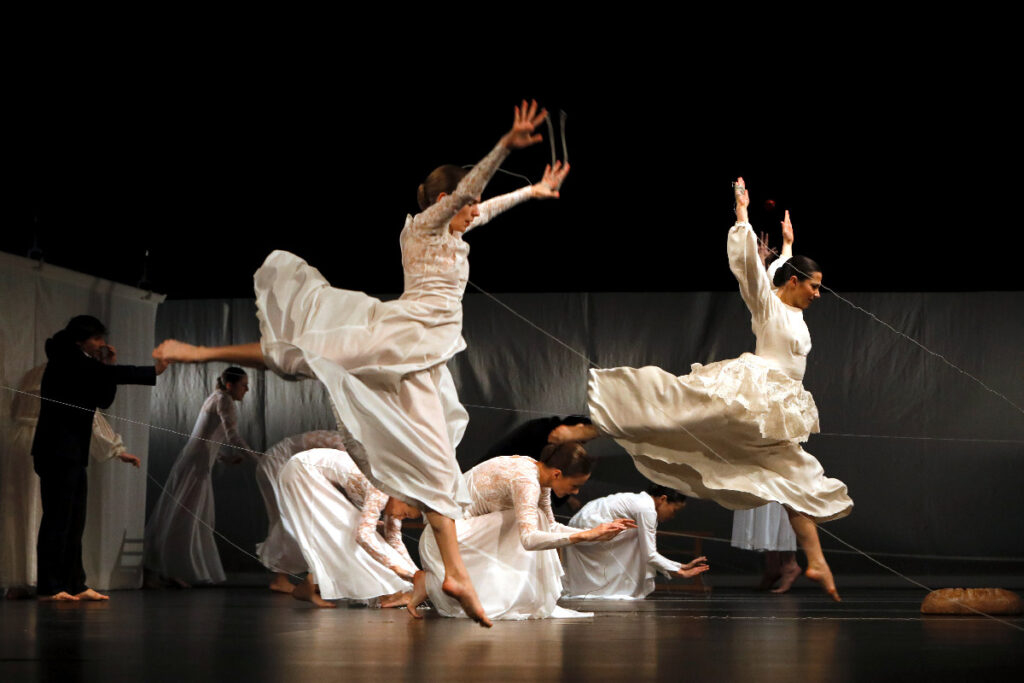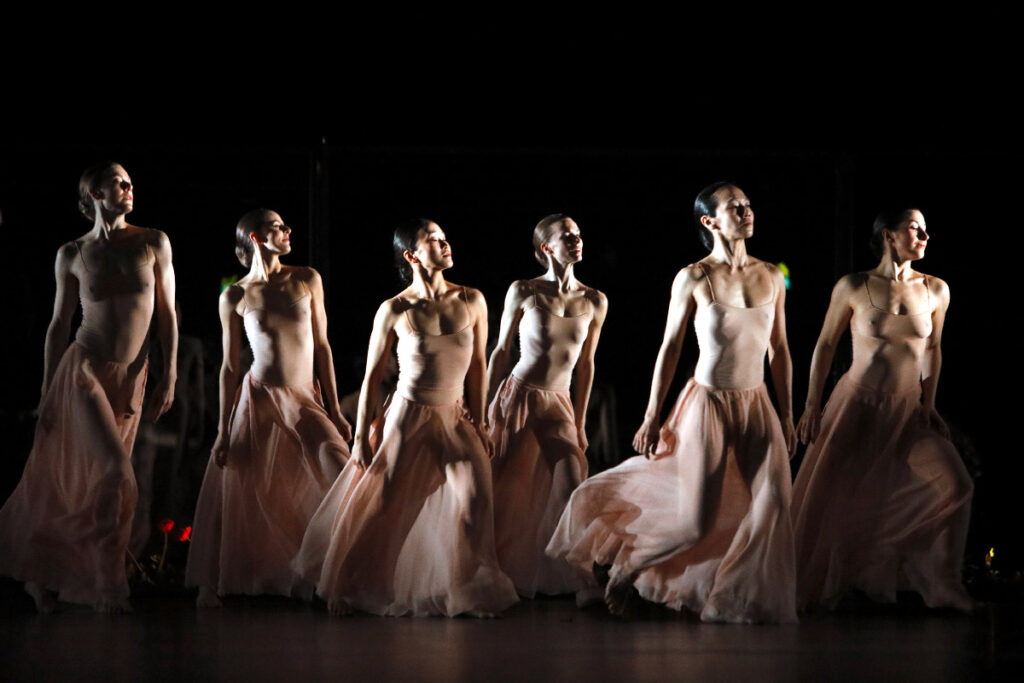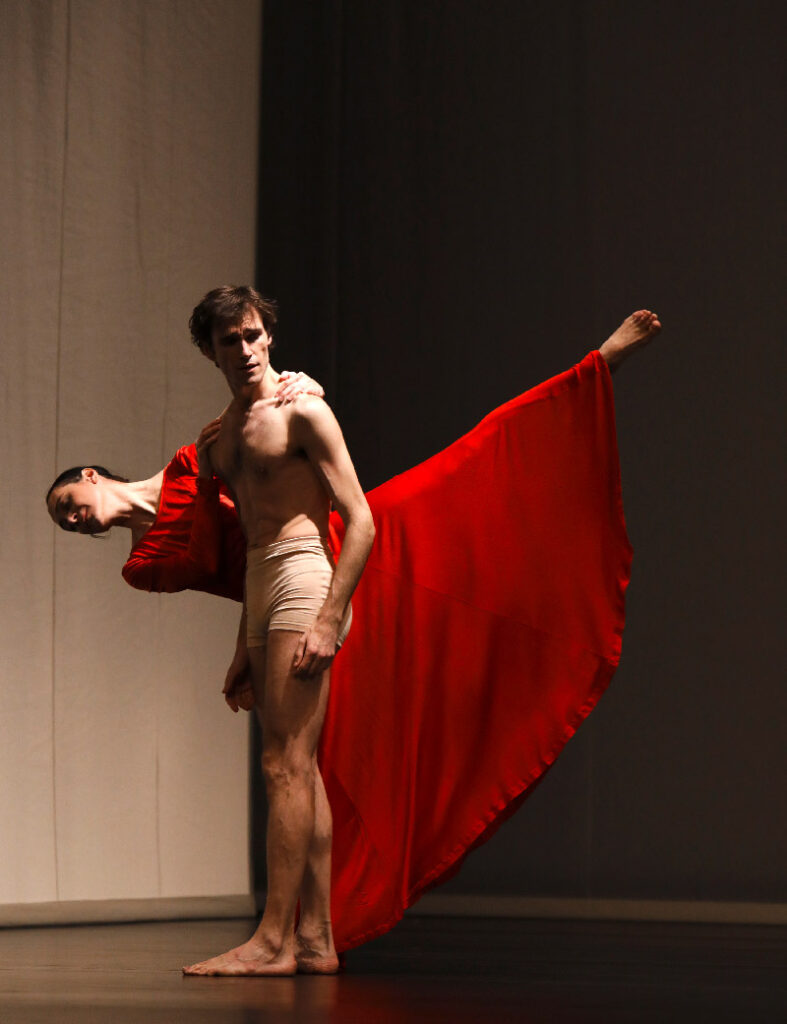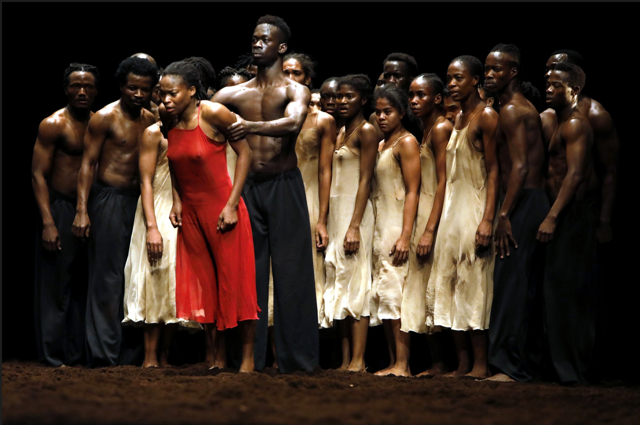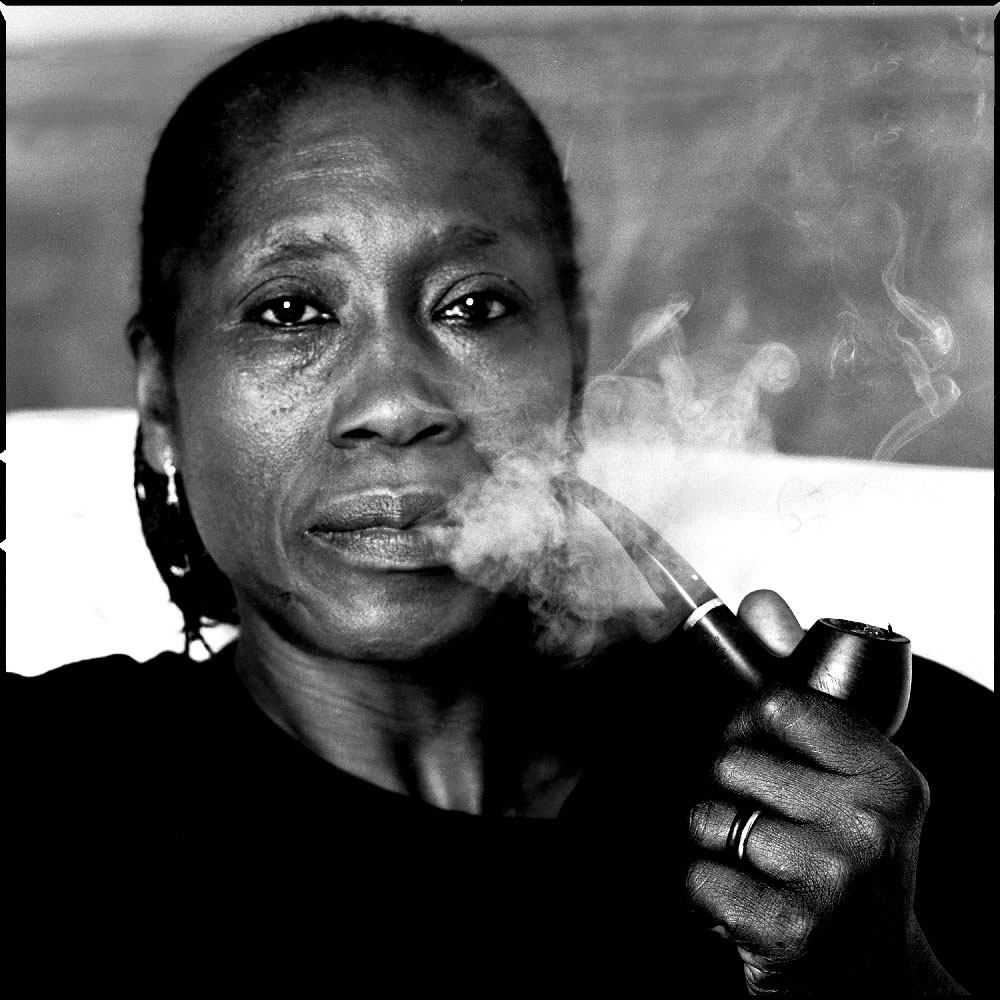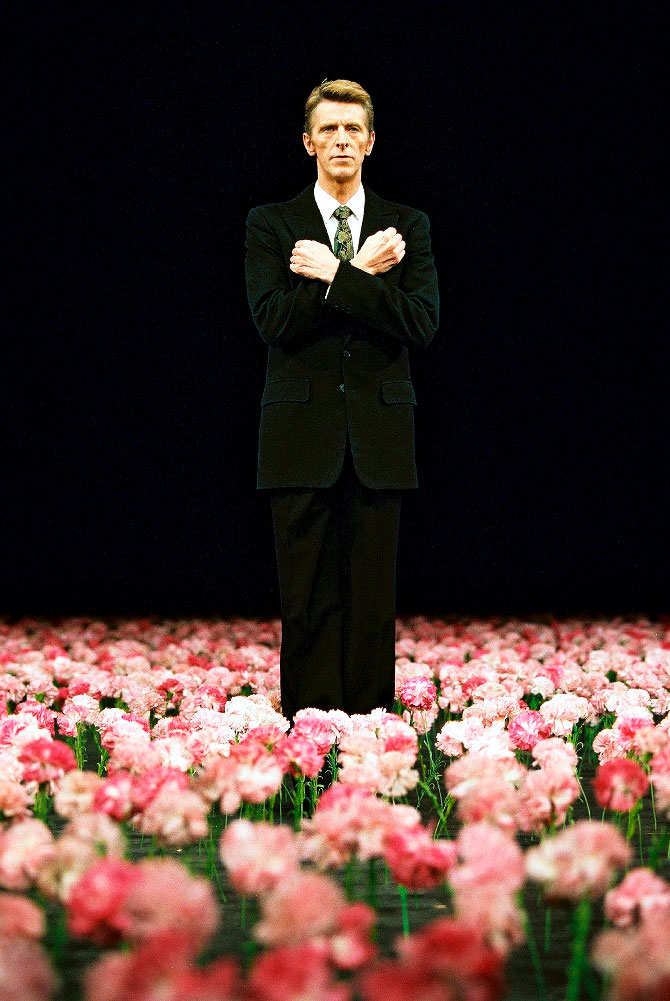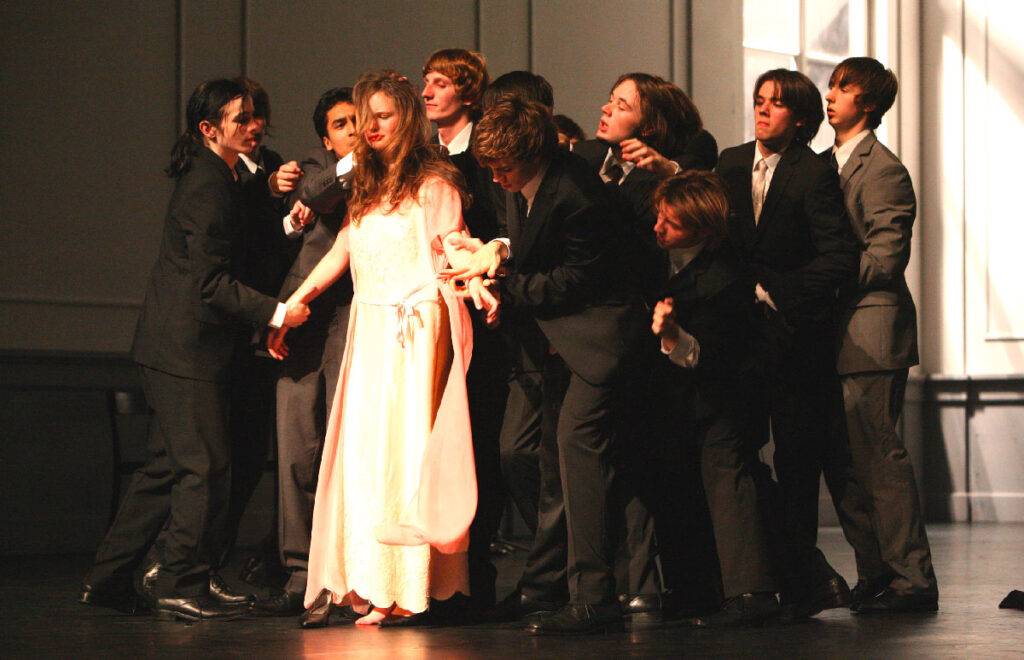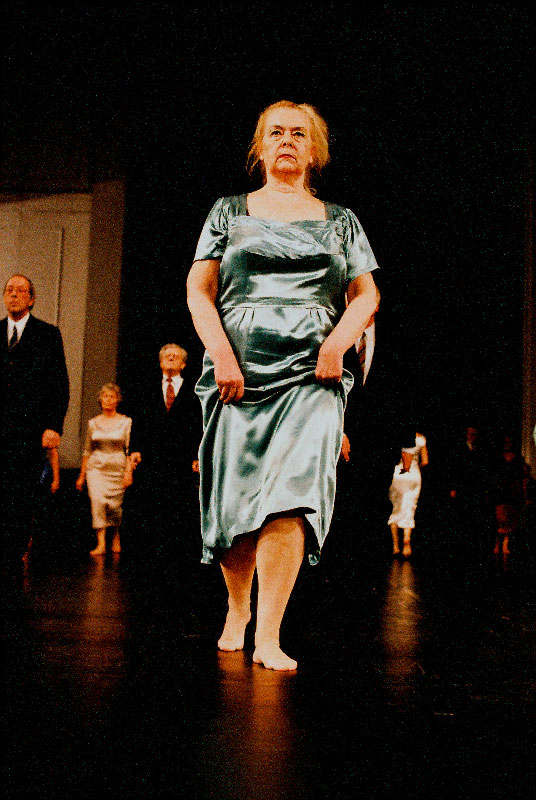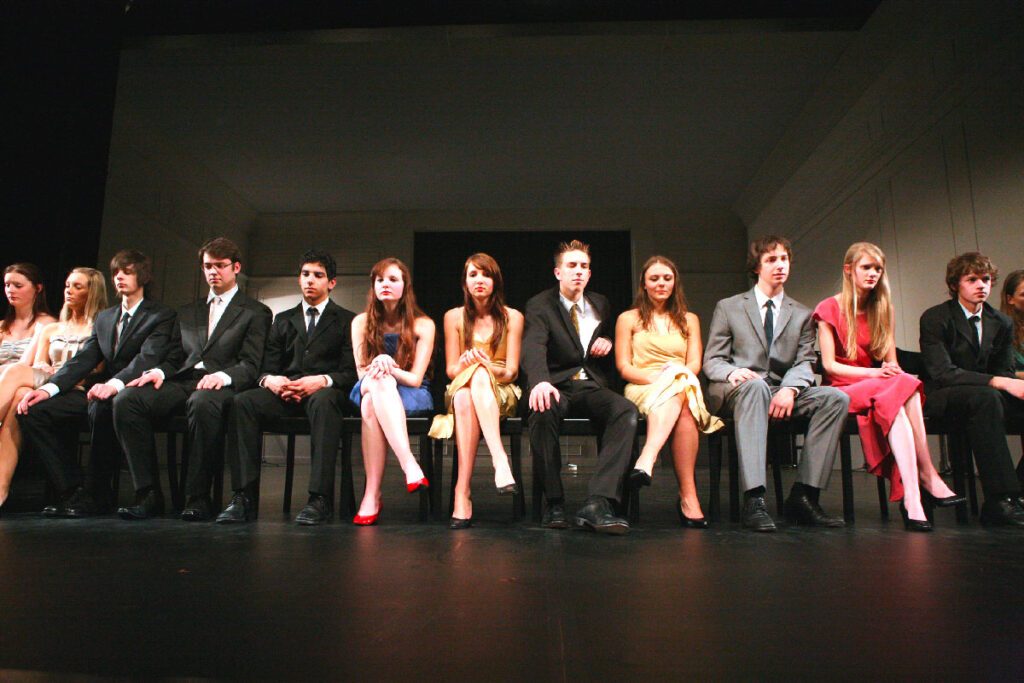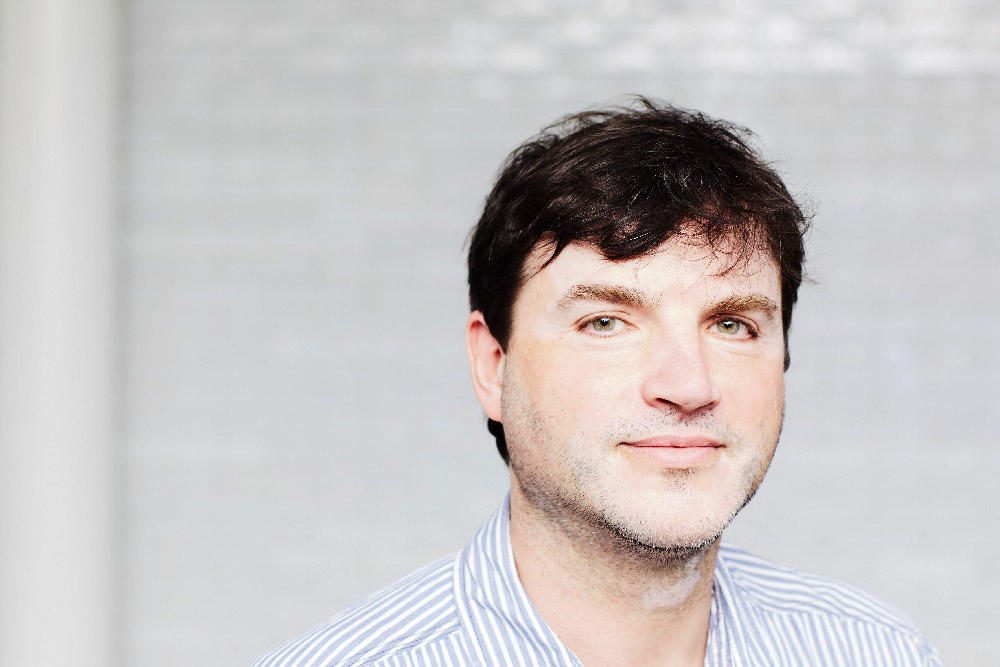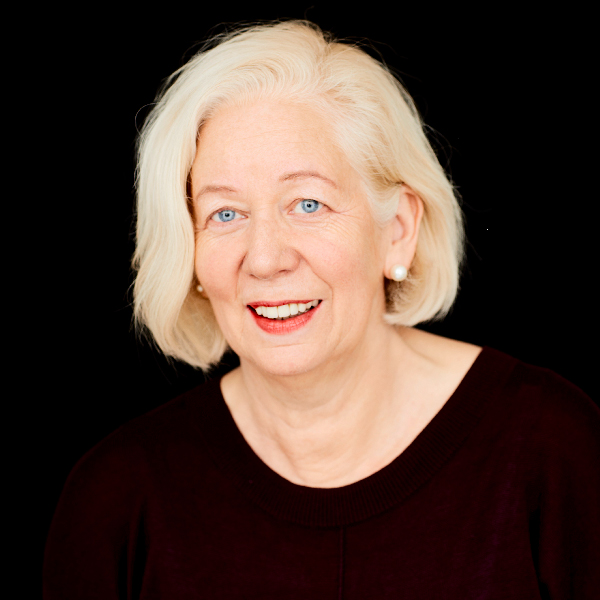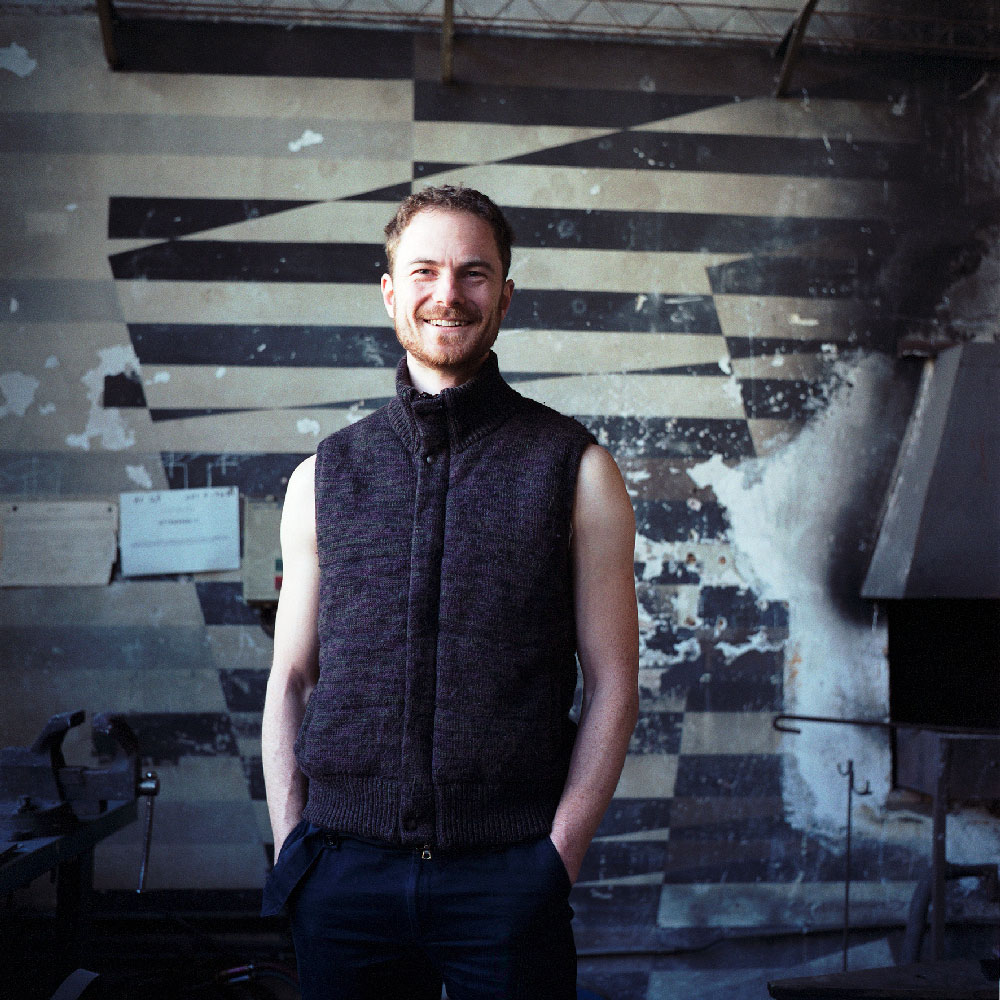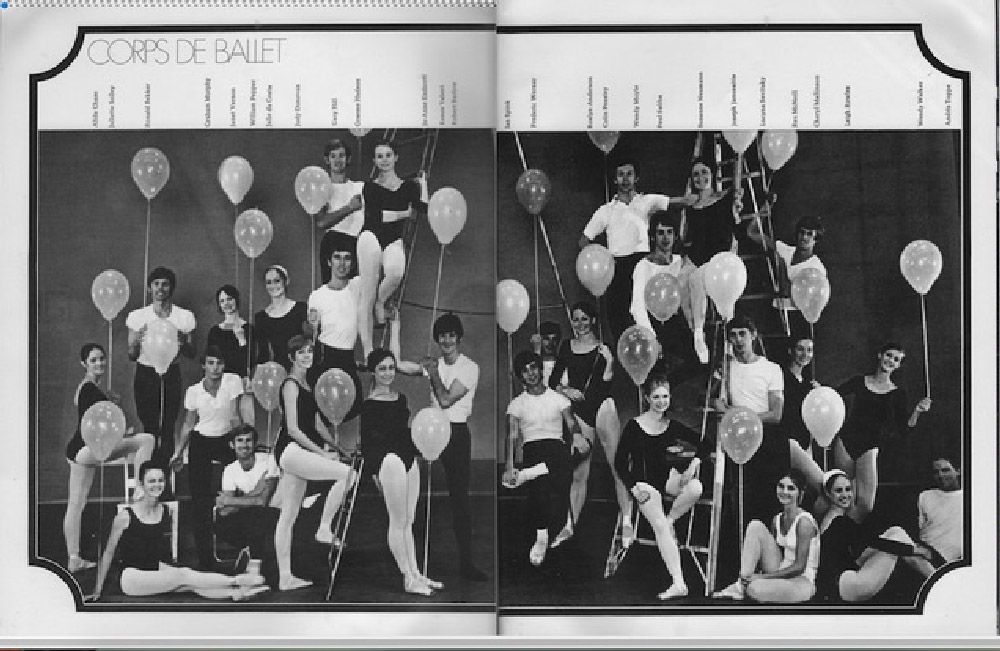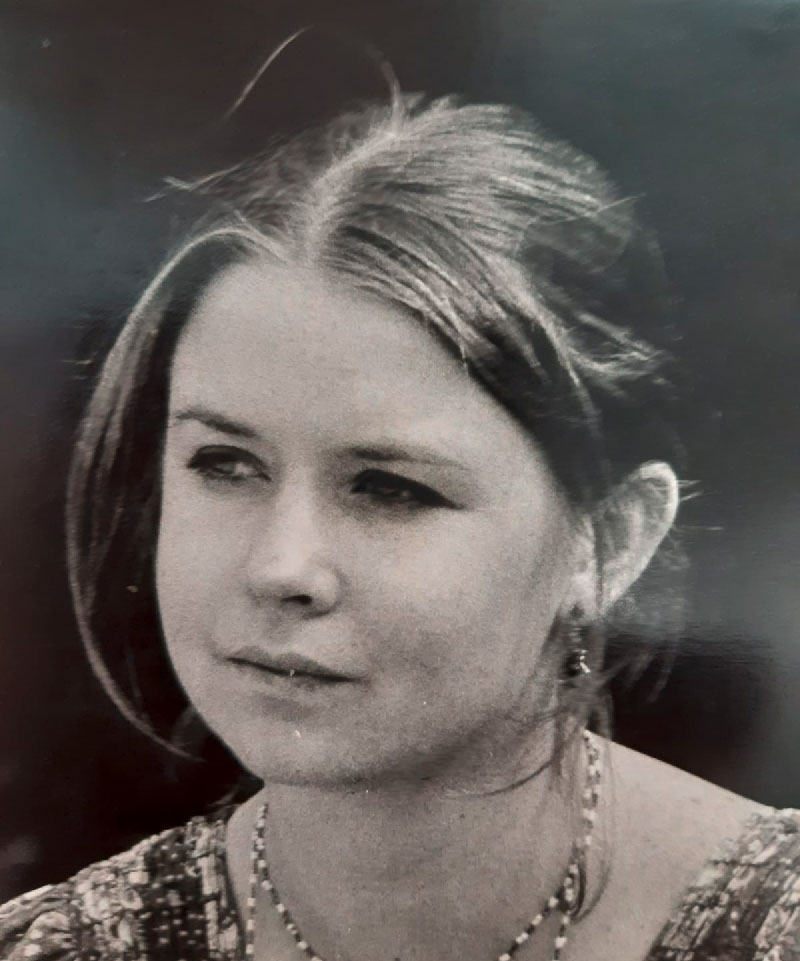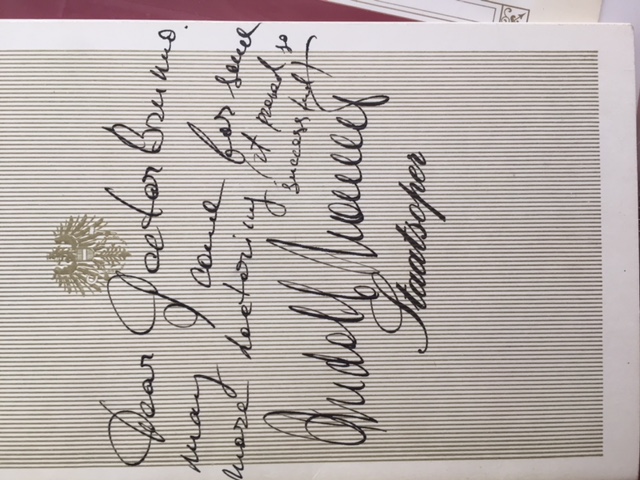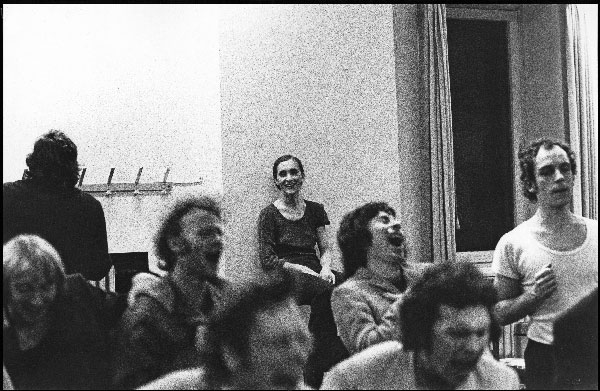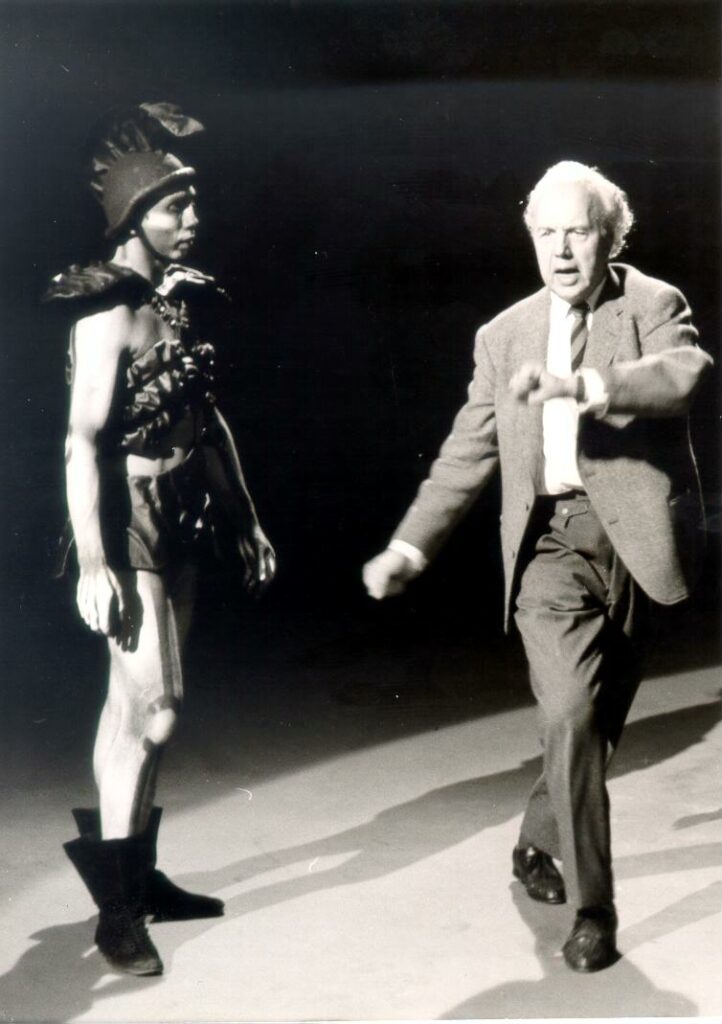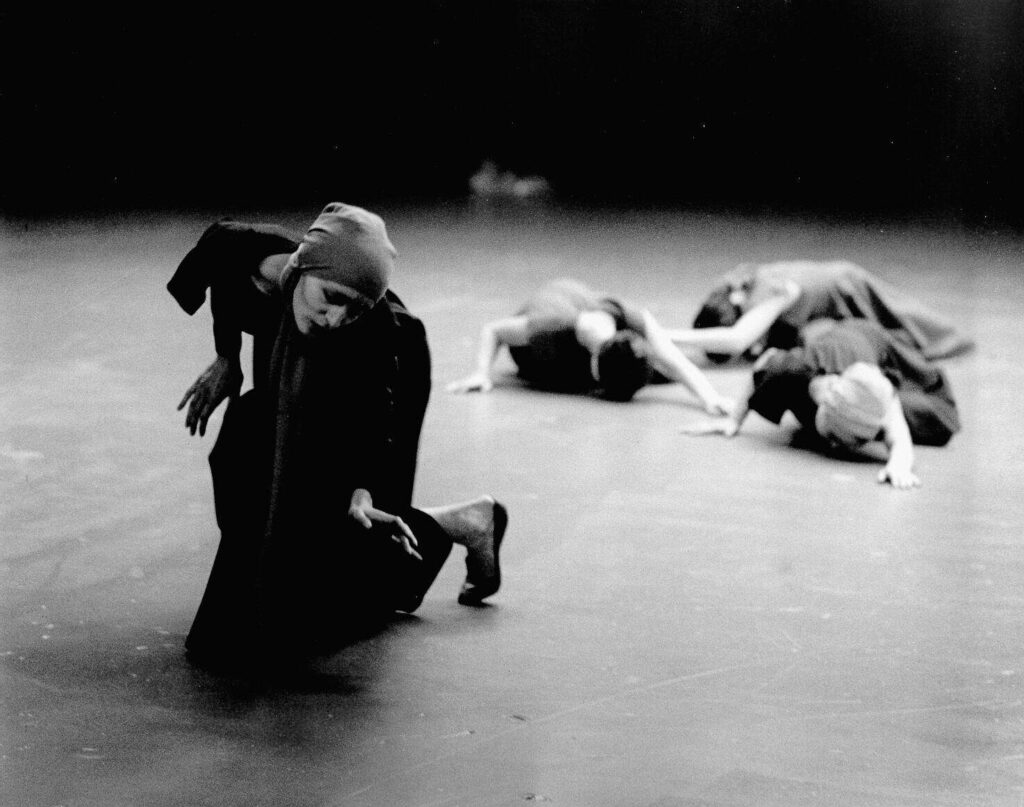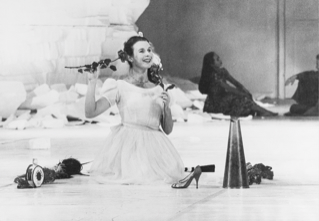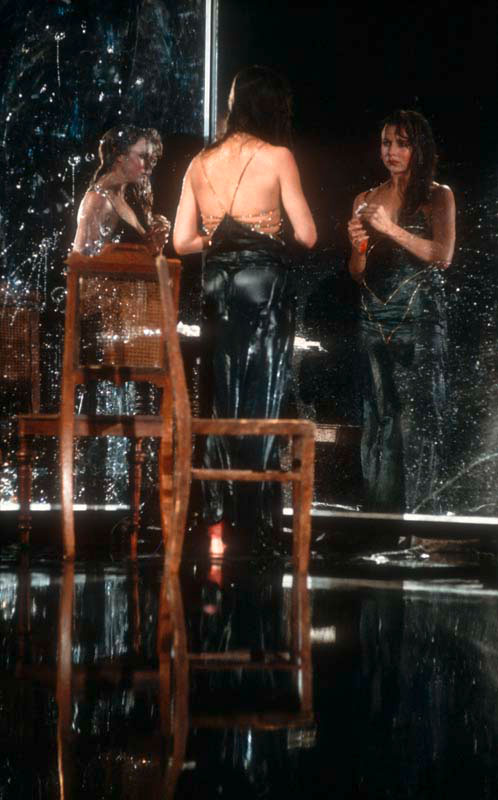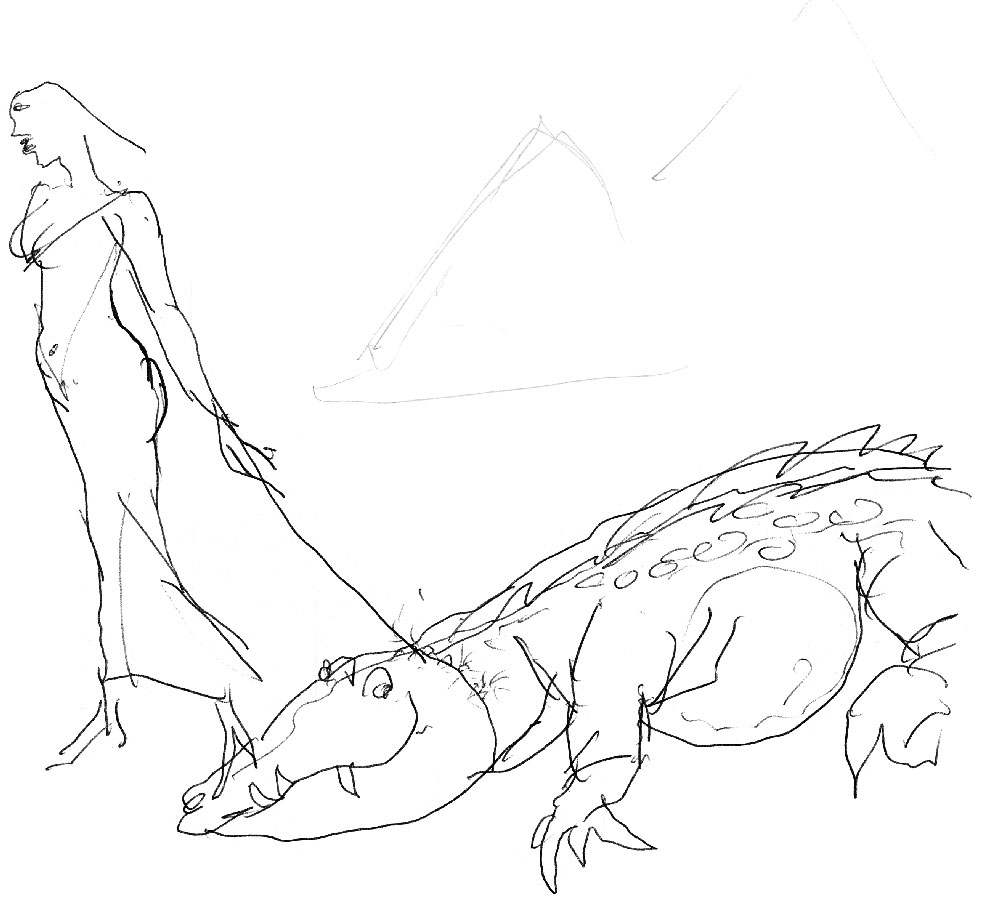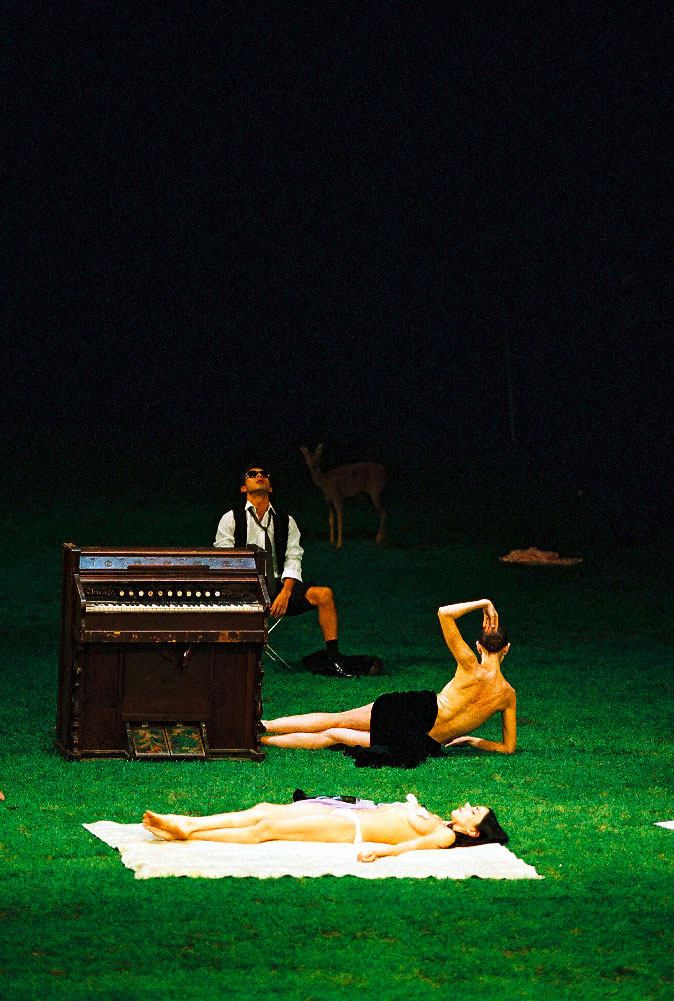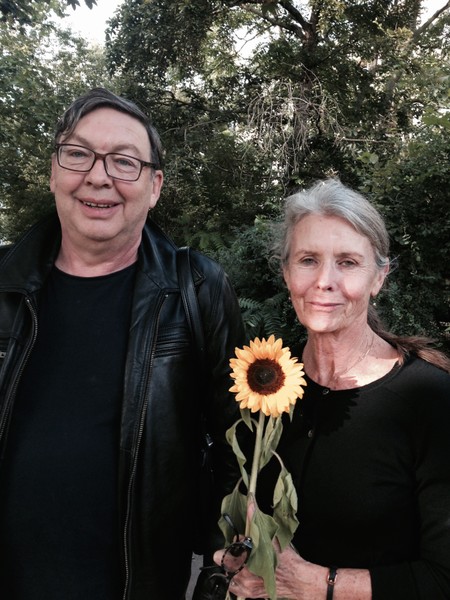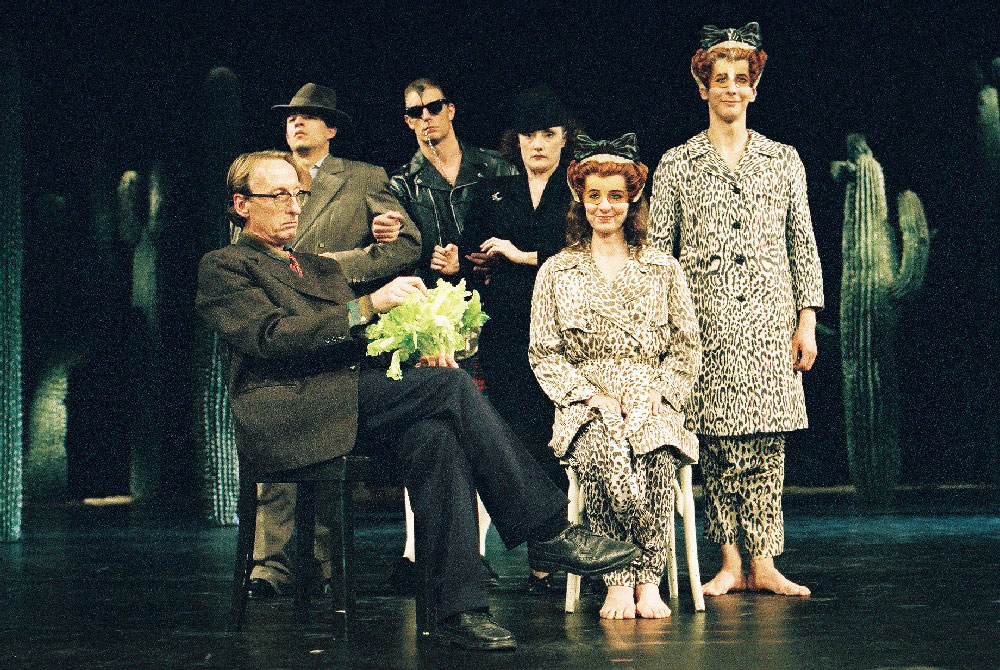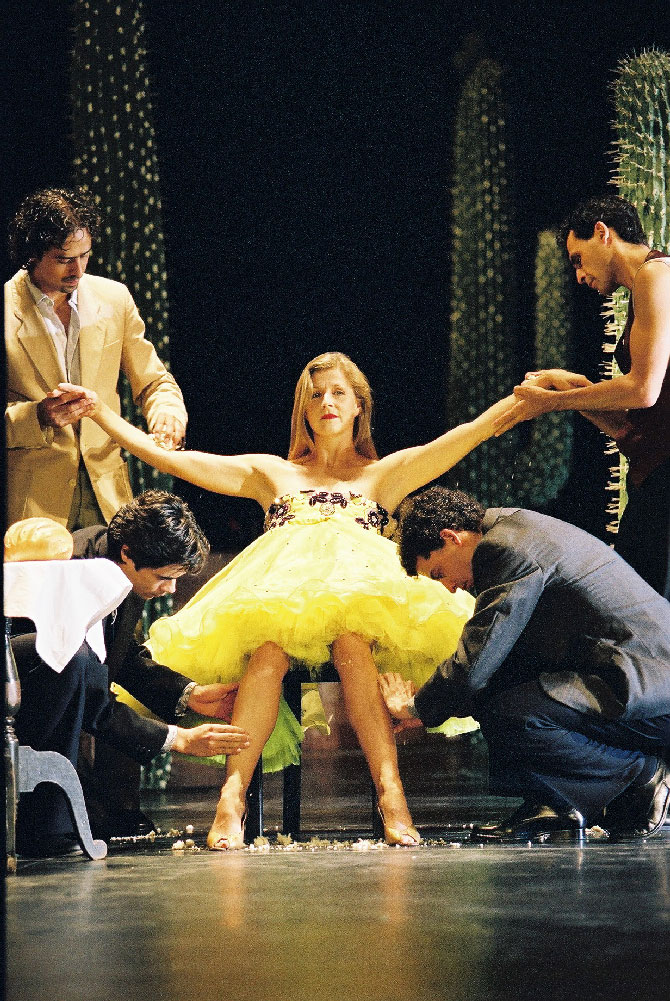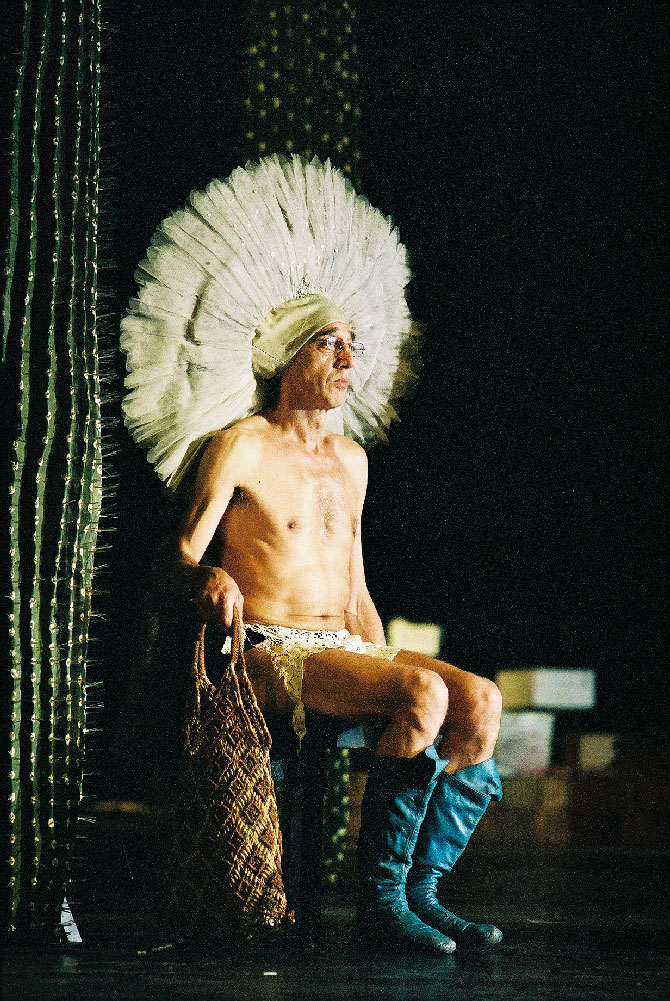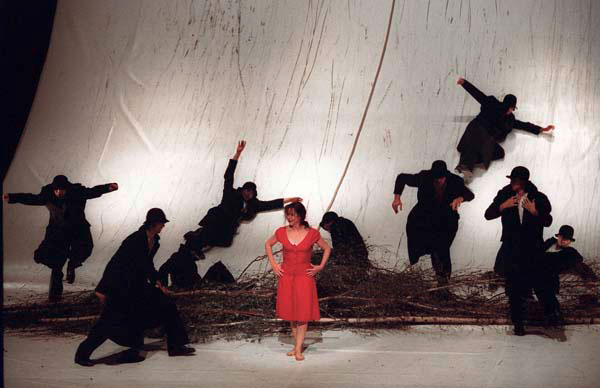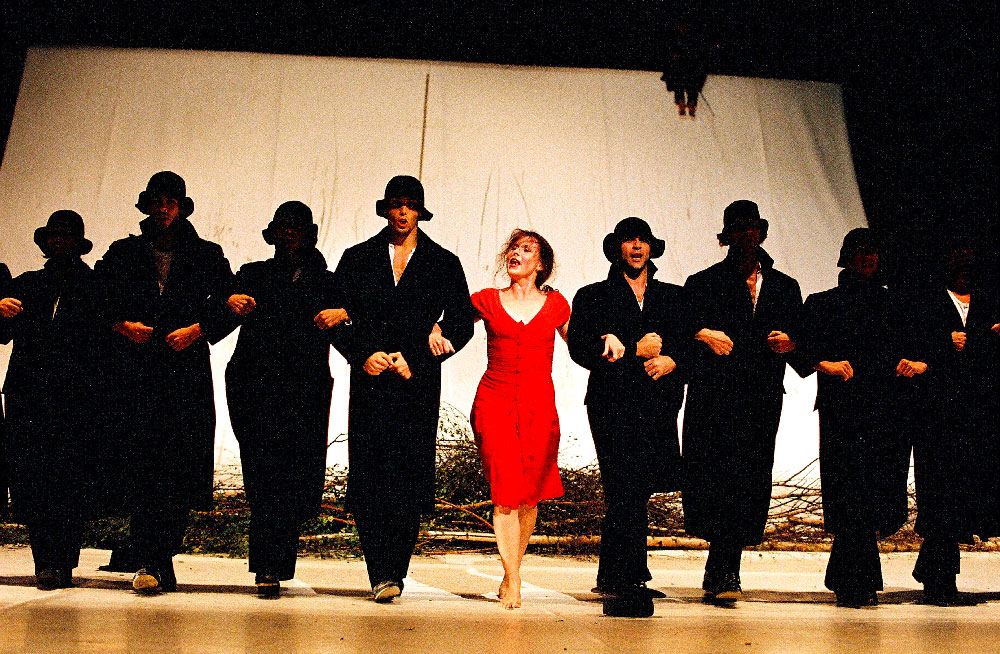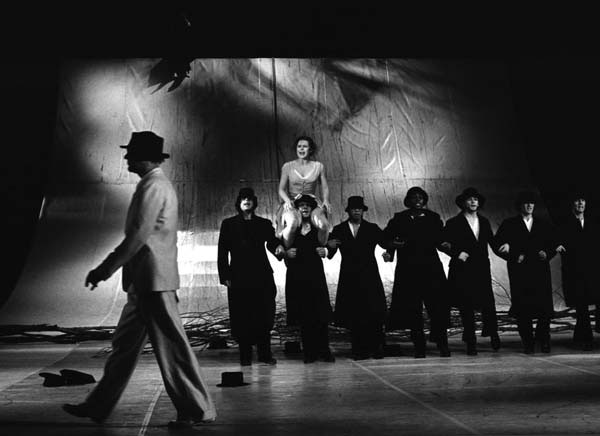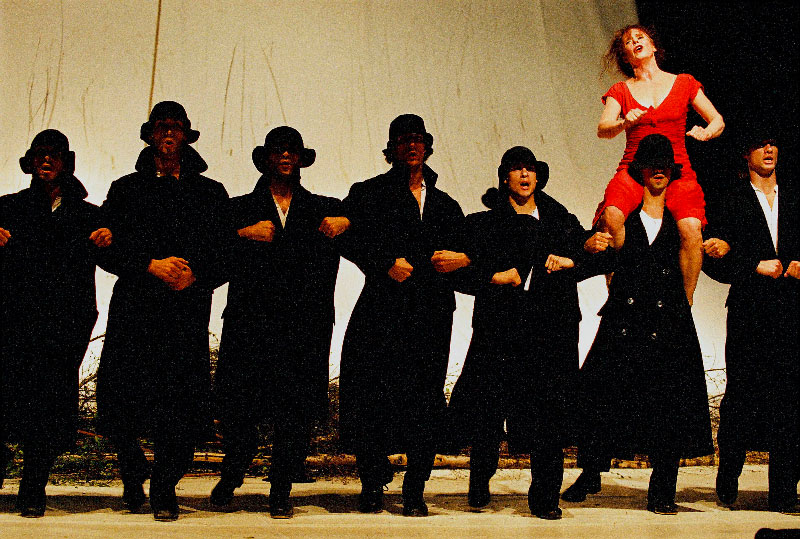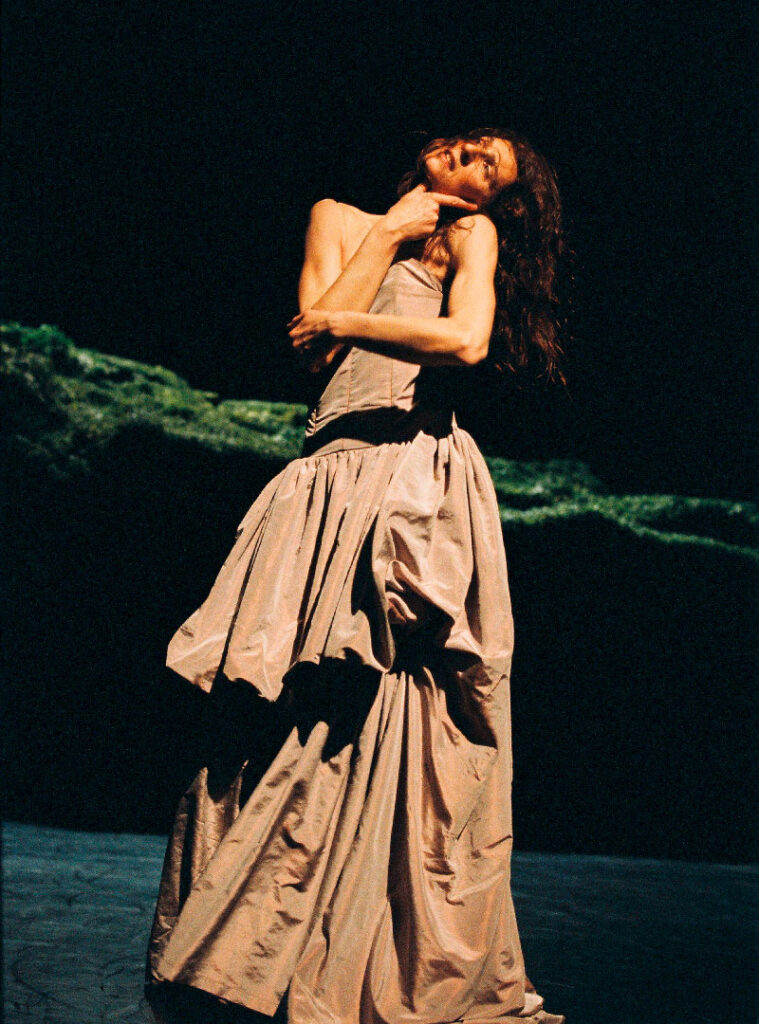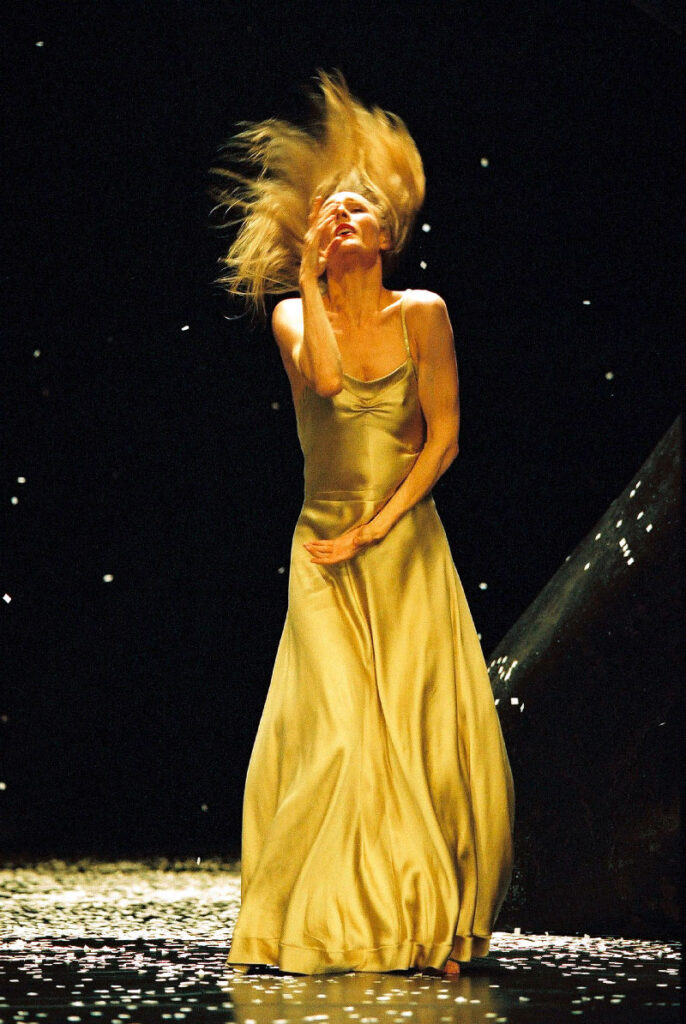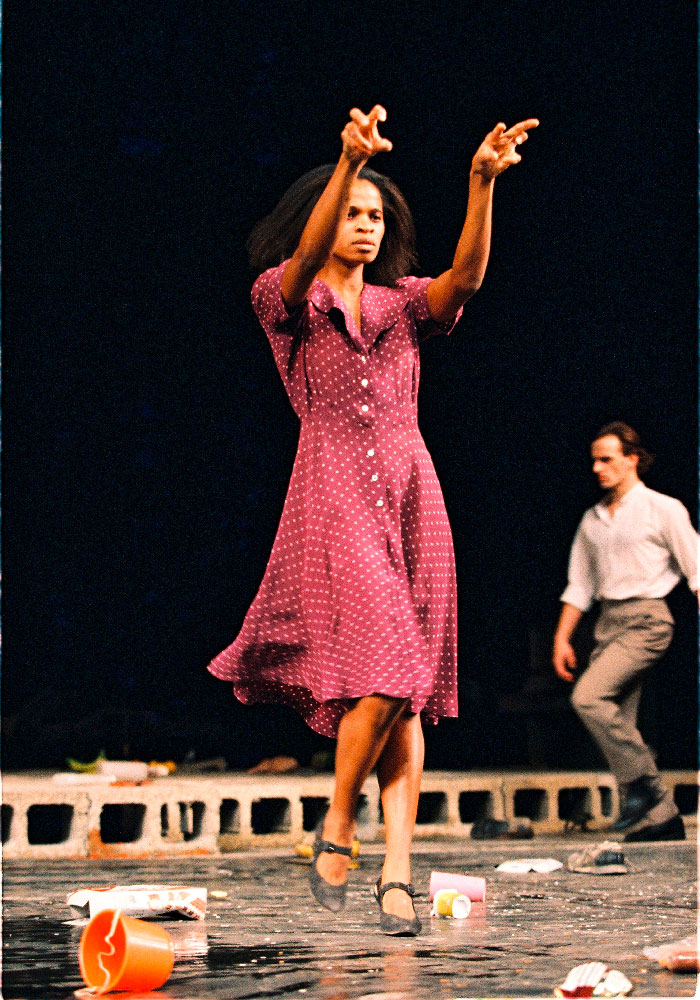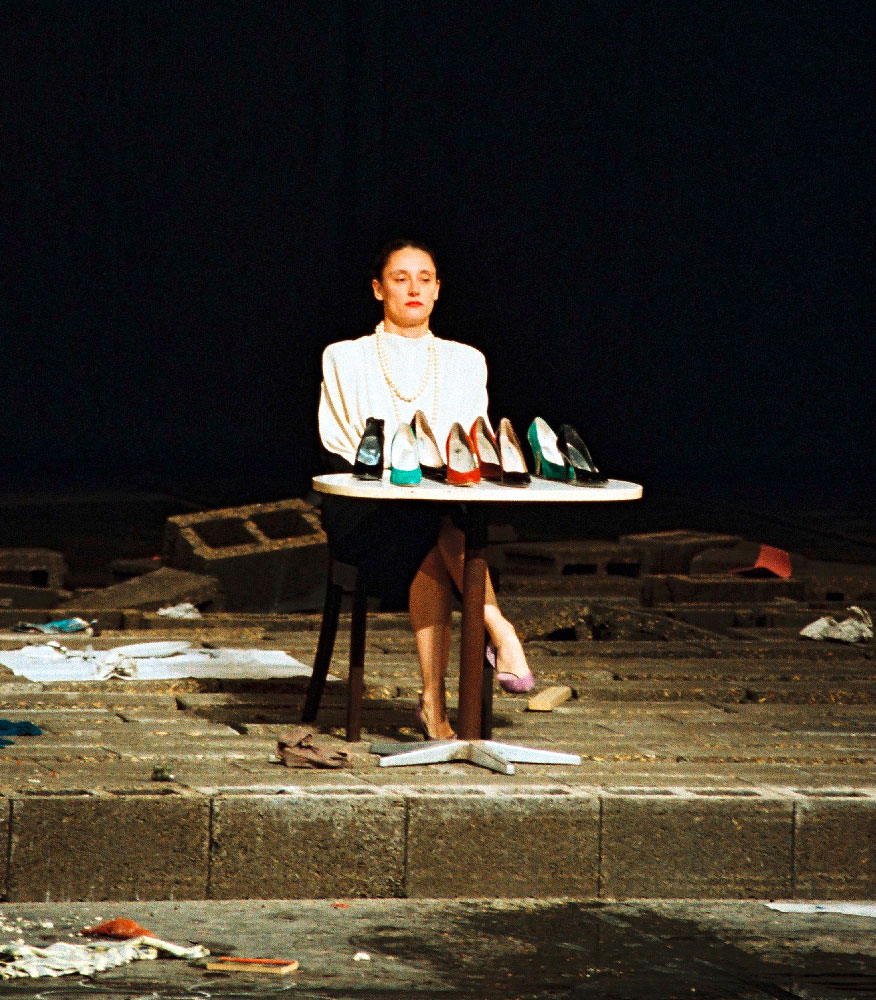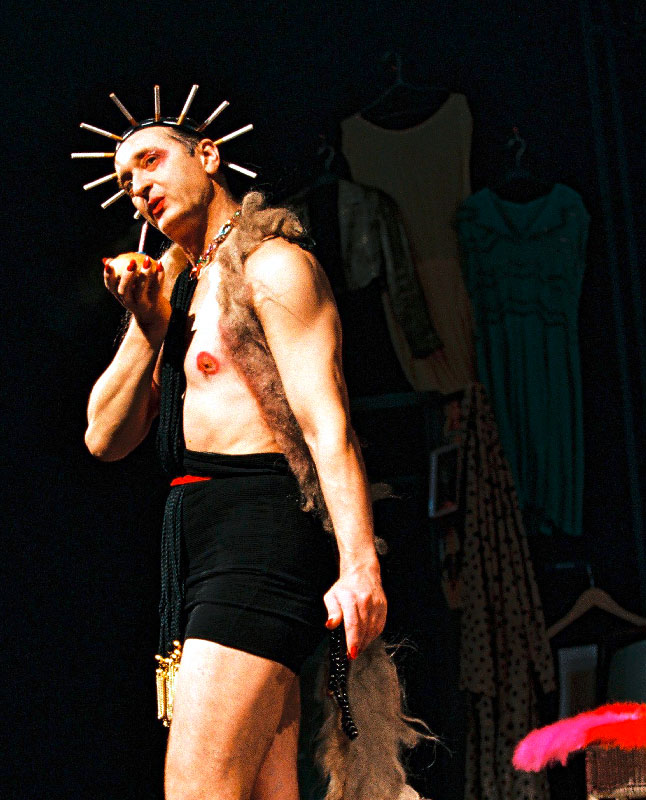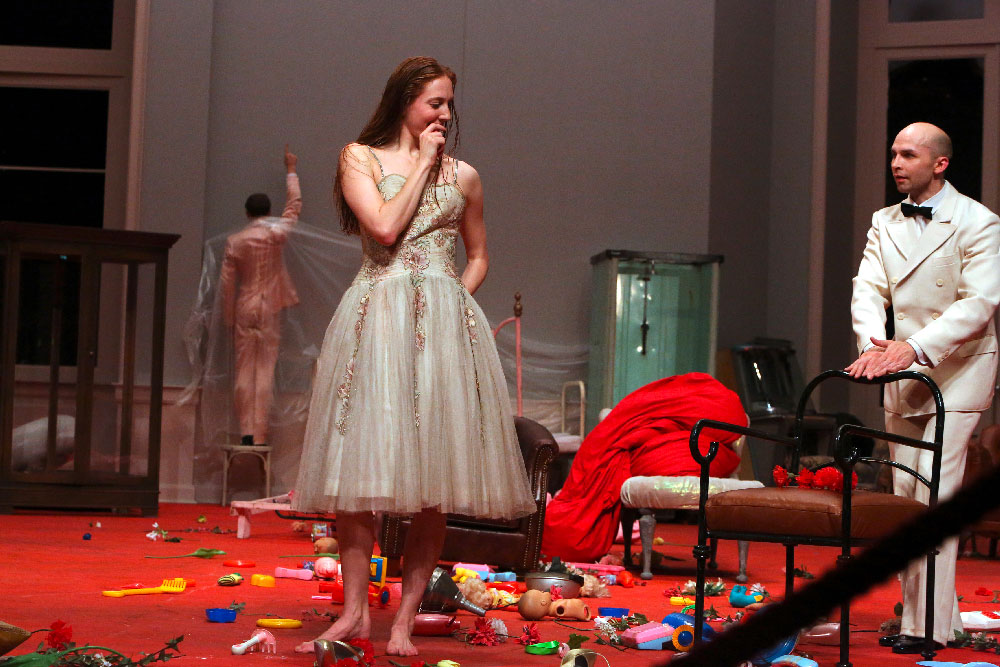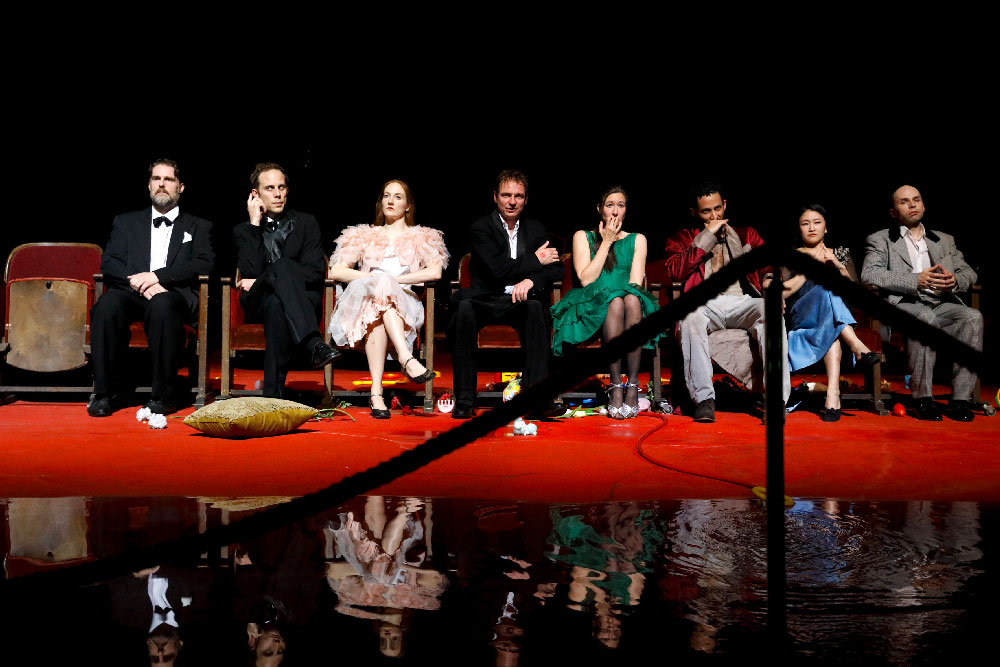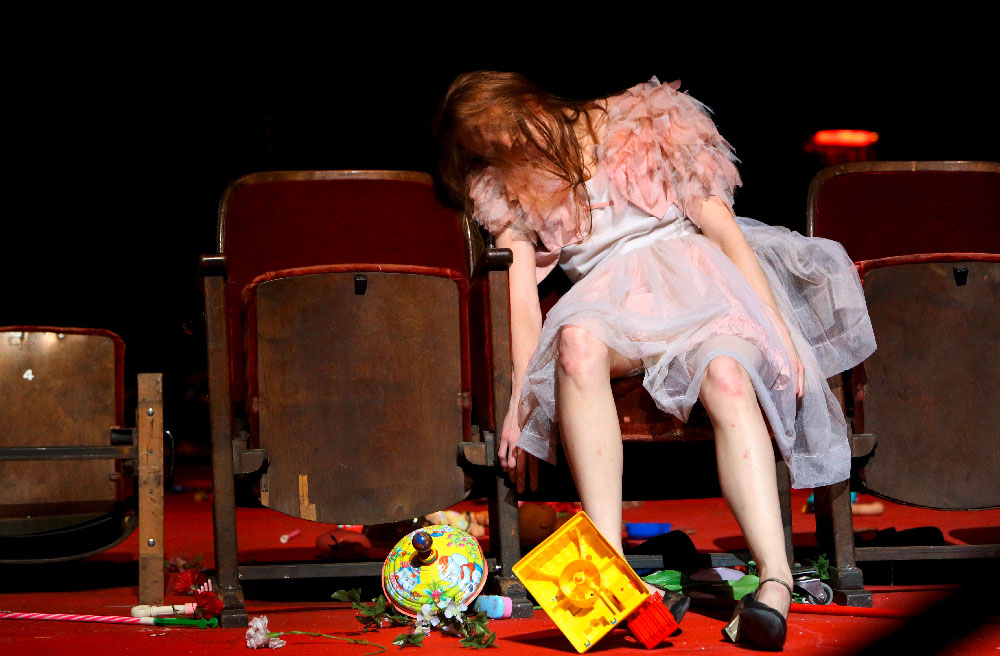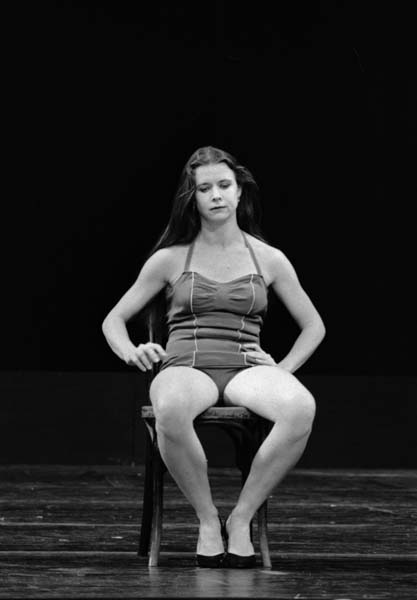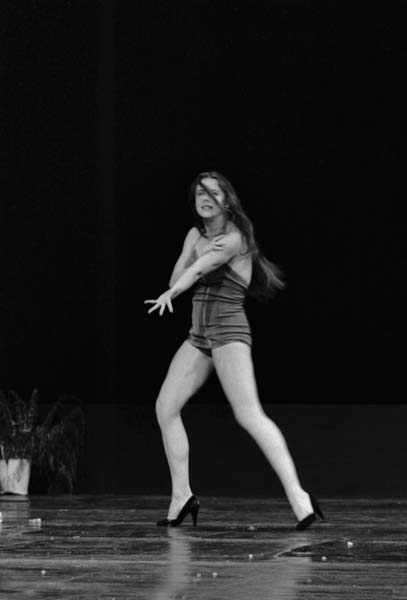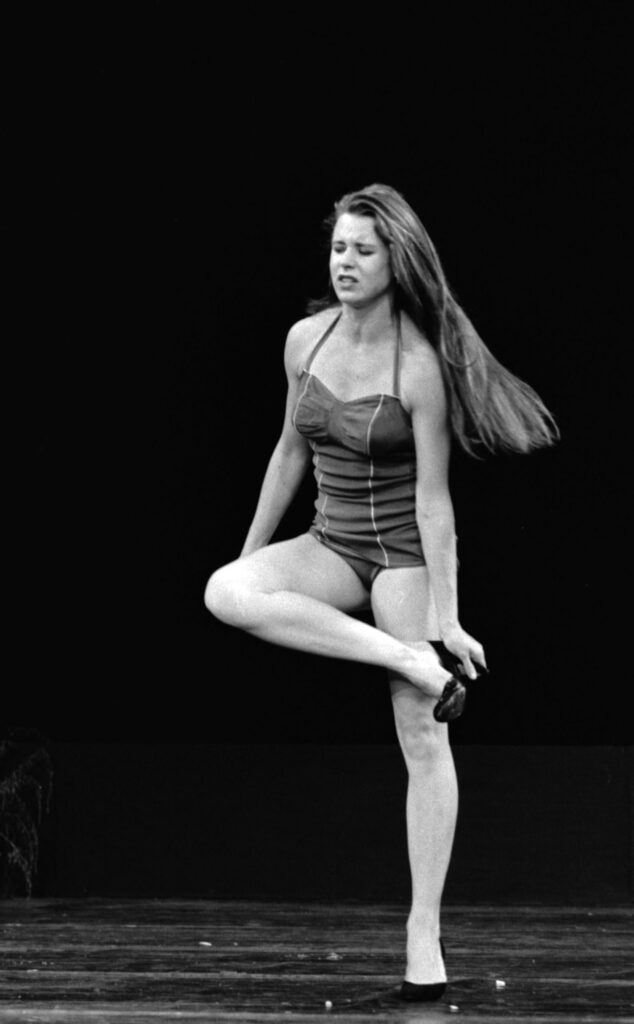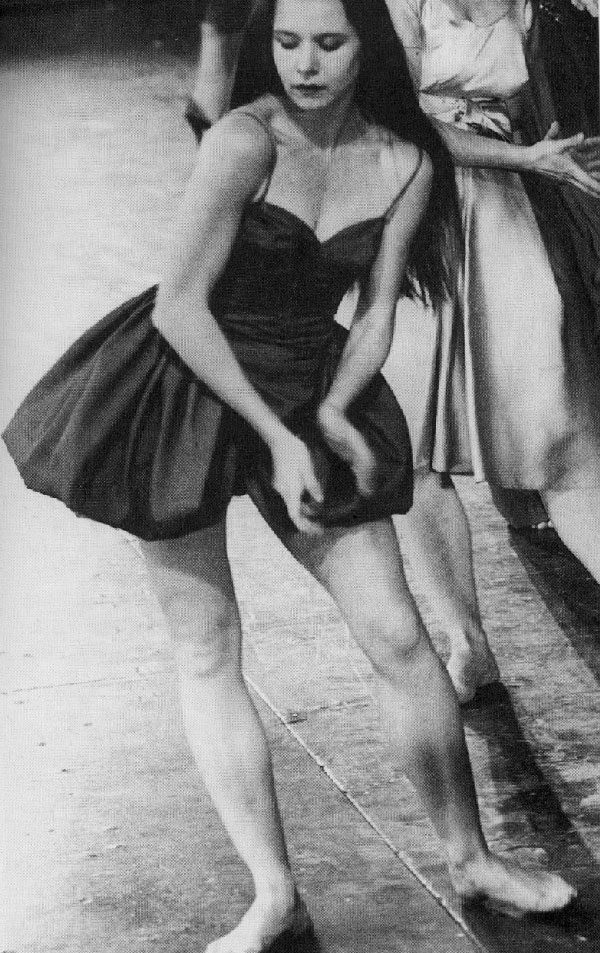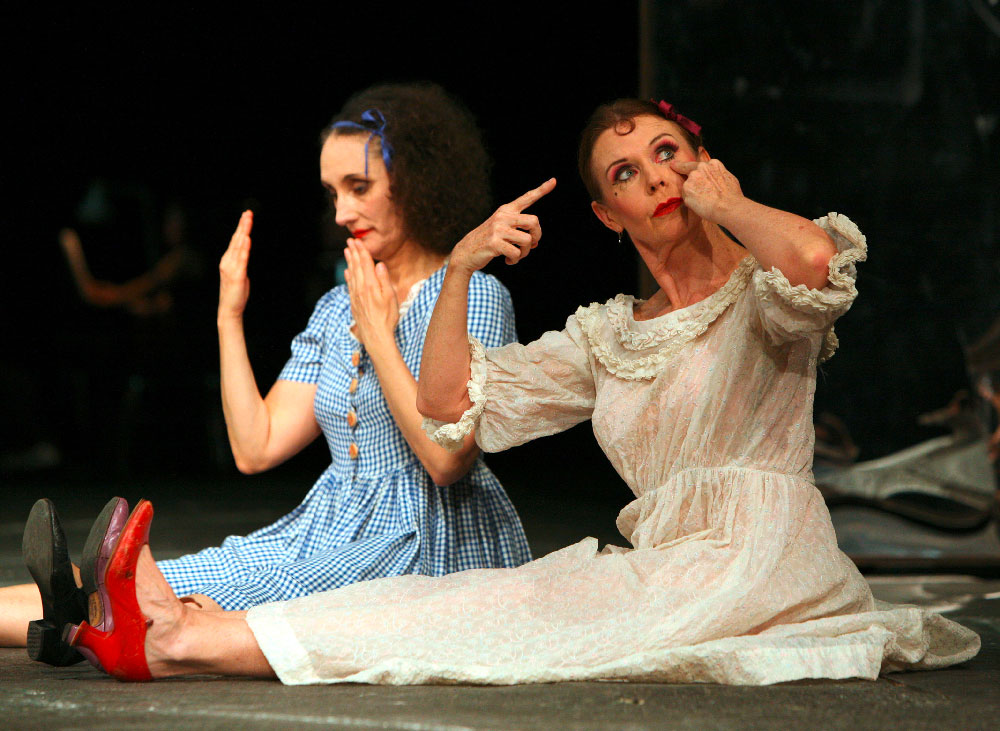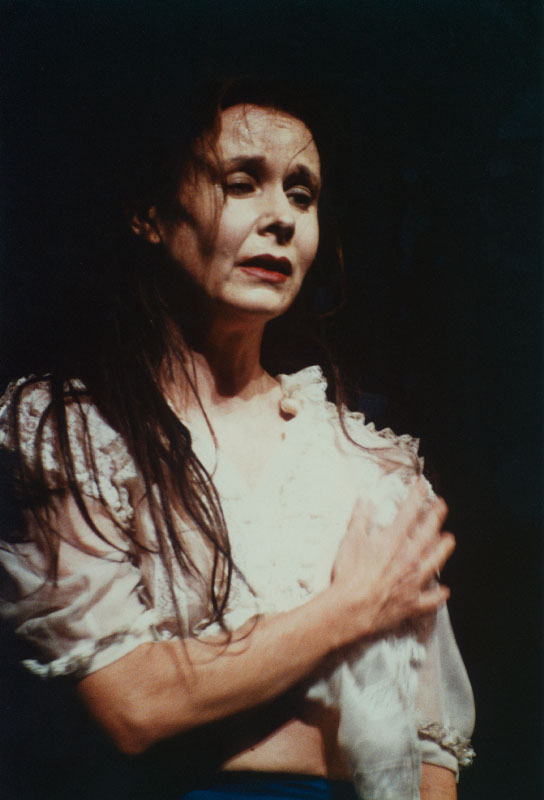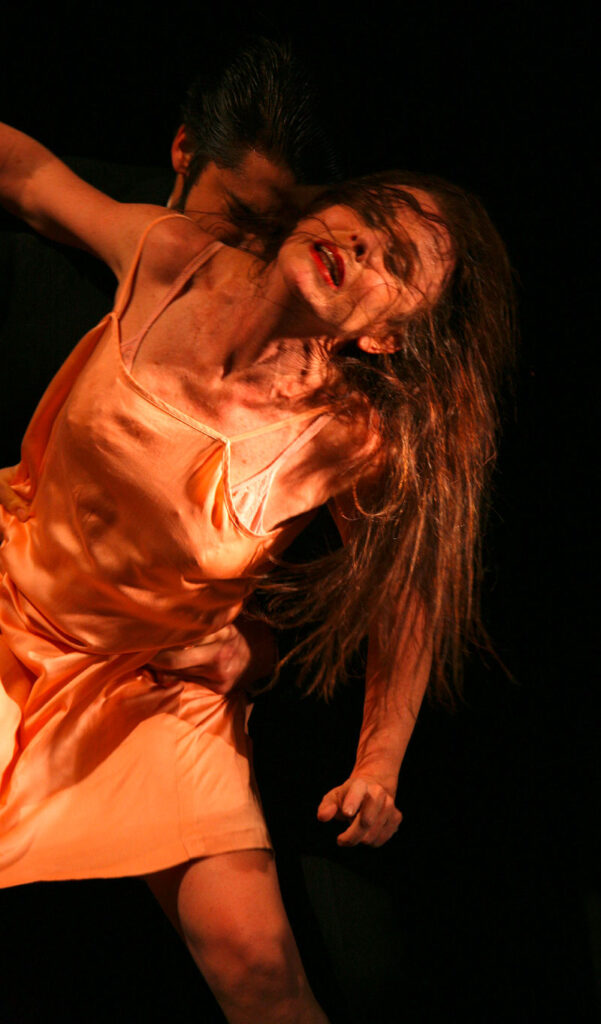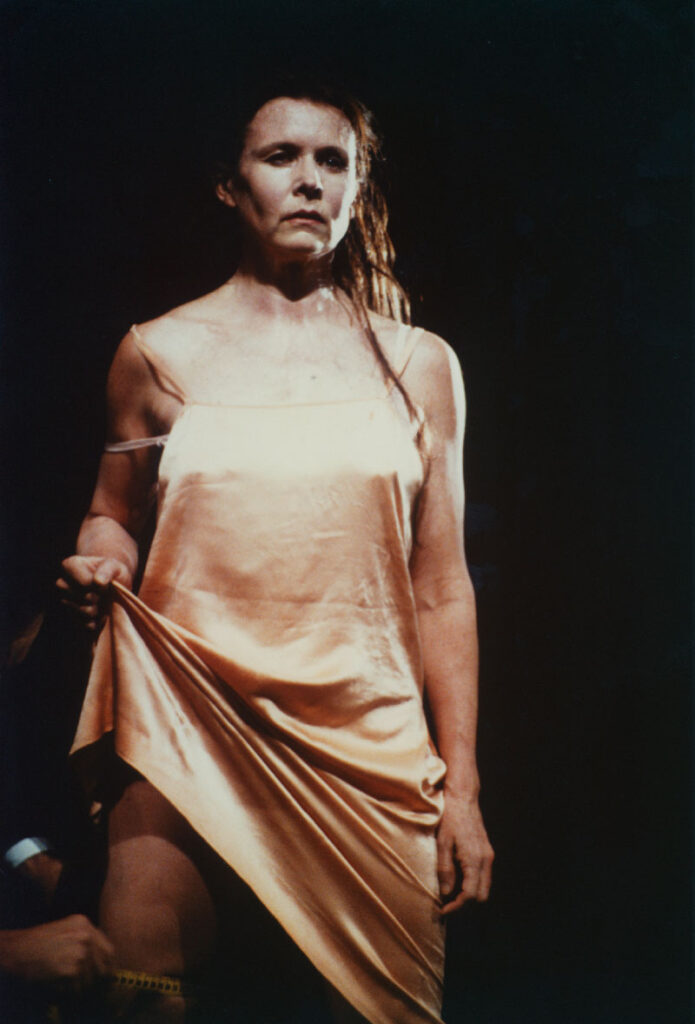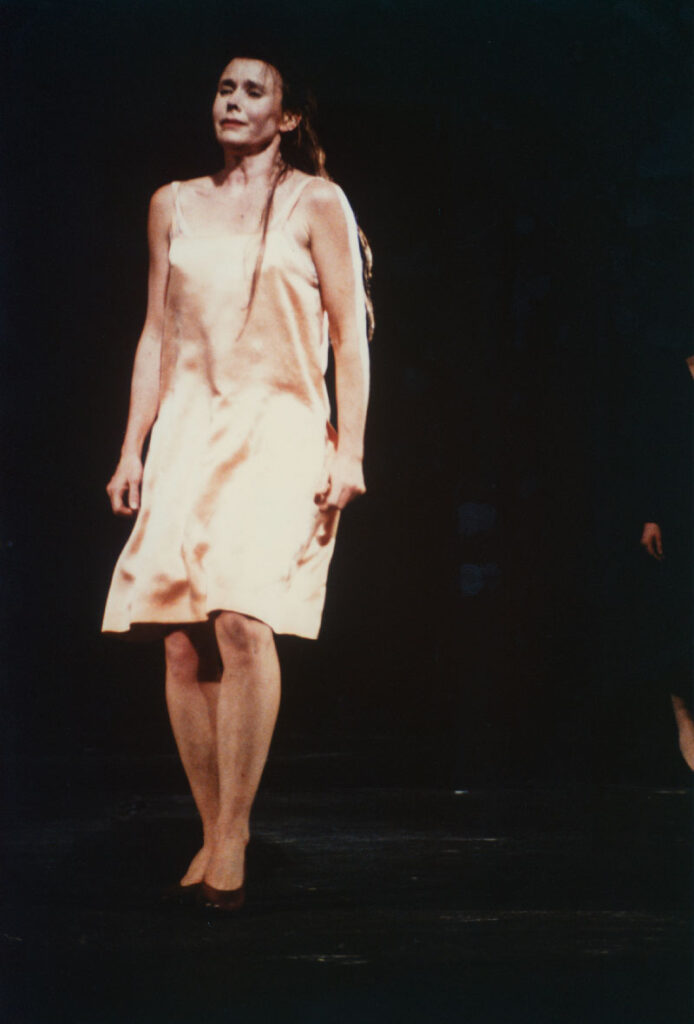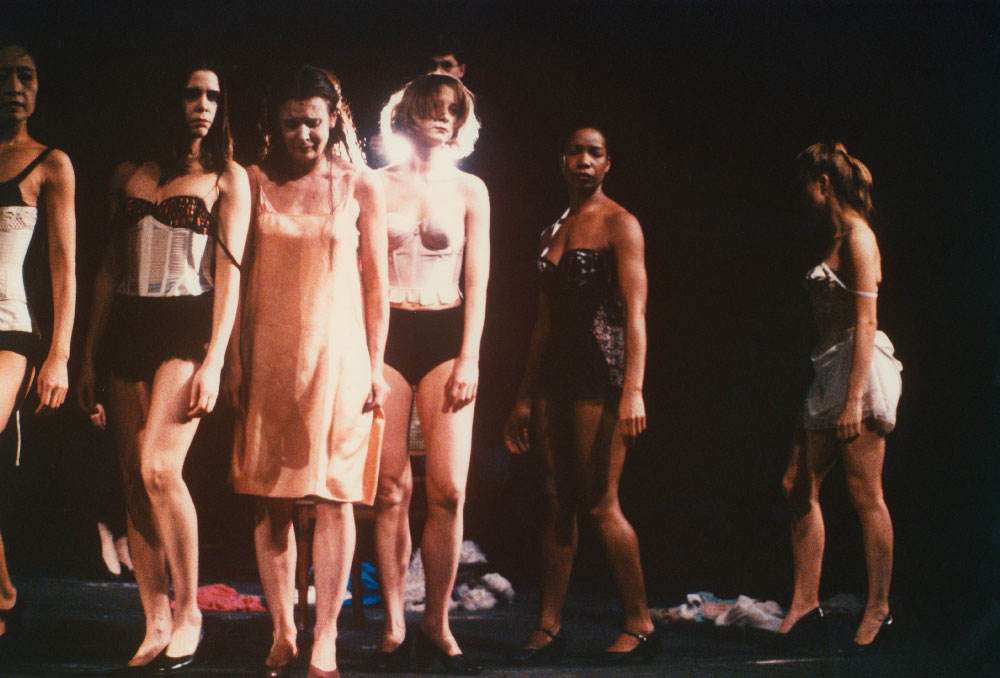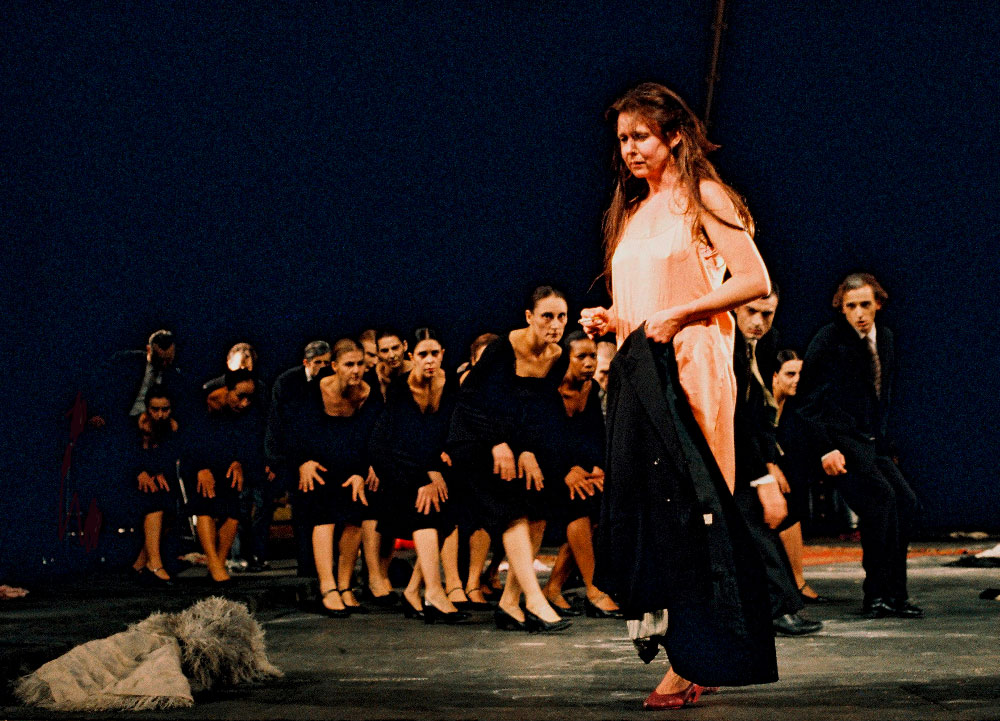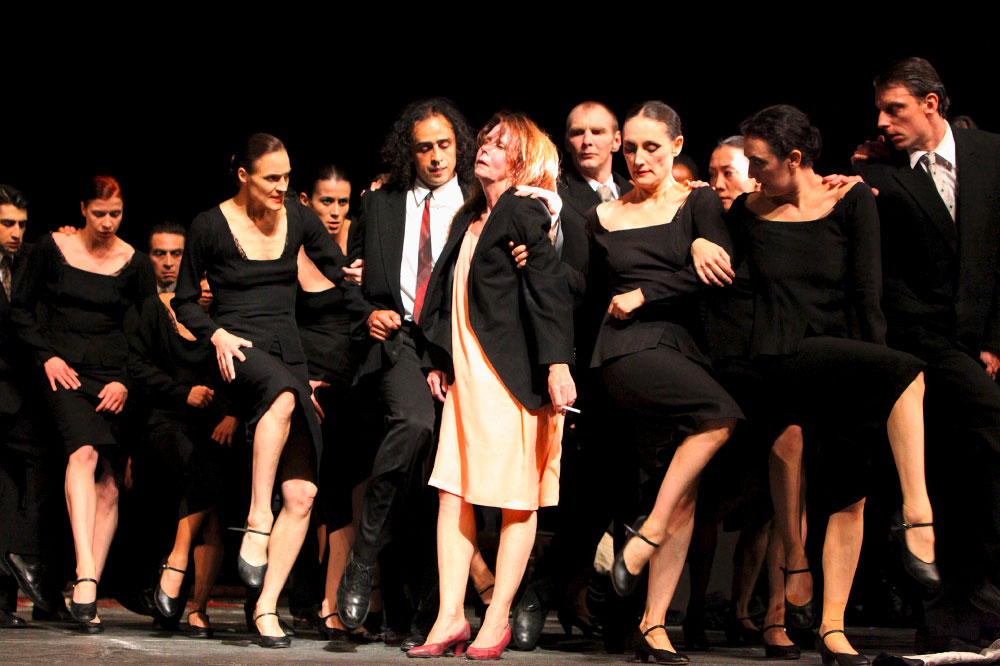The white stage floor was layered with dry, dead leaves. To begin, Judith lay on the floor with both hands lifted above her body. Bluebeard stood barefooted behind his tape machine in a thick, black woollen overcoat, black trousers, and white shirt. In the silence, he walked over to Judith and laid himself onto her stomach – his head fitting perfectly into her hands. Judith was a small woman wearing a light blueberry- coloured dress. It was very open at the back with just a hat elastic holding it across her shoulders so it wouldn’t fall off. Bluebeard was a largely built man. With her feet she pushed herself with the weight of his body little by little backwards until he stood up and ran to his machine to press start. Then stop. Then rewind. Then start. This went on for some time before she started to push him off her.
More than half of the audience left during the performance, and by the end I could count on my hands those who stayed. Despite Pina’s ingenious interpretation, Bluebeard drove the audience to rage, and many of the dancers round the bend. It was a great piece, but given the blatant brutality, just how far is art allowed to go? In the shower after the performance, I saw the back of the ballet’s Judith; it was full of bruises. Jan Minarik played a brilliant, unforgettable Bluebeard, and Marlis Alt was his Judith. 1985 was, I think, the last time I danced in Bluebeard. It was filmed.
In 1994, we heard that the Bartok estate rescinded the Tanztheater’s performance rights, displeased by Pinas use of Bartok’s famous music. Twenty-six years later, Tanztheater was permitted to perform Bluebeard again. Historically, it was important to revive Bluebeard as so many people may not have known this dark side of Pina’s early works. For interest-sake I forced myself to watch the general rehearsal but personally found it weakened in its intensity. The Judith and Bluebeard dancers were good. Perhaps the group of dancers just needed more time to grow in to this intense, disturbing masterpiece piece. As an insider I was disappointed. Perhaps it is unfair to say as I know from my own experience with Pina that miracles can happen between what you see in a general rehearsal and what you see in a premiere but I decided not to stay for it. Nevertheless, I decided not to watch the premiere. Viewers who do not know the older Bluebeard of course found it powerful and liberating. Perhaps the group of dancers just needed more time to grow in to this intense, disturbing masterpiece piece. Or Jo should stop being so critical.
One day after a Bluebeard tour in Paris in 1985, I received a long letter by post at my home, from an unknown viewer who had seen Bluebeard. It was a letter of the deepest gratitude to Pina and me for the impact and miraculous healing affect Bluebeard had on this man, and from what he wrote it saved his destroyed life as it put an end to any further thoughts of suicide.
Several years later, a woman with a very deep voice came to visit me at my home. She was holding a bunch of flowers in her hands. I said, “Come in and I’ll make coffee.” Her hands seemed too large, feet too big, her size too tall for a woman. She began to tell of her coming out, and how, at the age of eleven, she took hormone blockers to avoid male puberty. Several years later she was given female hormones to enable gender assignment surgery. She also said that she had stumbled on to a photo of Pina, which fascinated and attracted her so much that she wanted to know more about this woman and Tanztheater. She did research on the internet, listened regularly to the music of the pieces, Sacre, Todsünden, Bluebeard, Kontakthof, and read my books. All this Pina research gave her the courage and strength to go through with her outing operation instead of attempting a fourth suicide. She thanked me deeply.
Amazing what Pina’s works set free.
AN UNHAPPY PINA
I am now writing about the year of 1998. The sun-drenched city of Aix-en-Provence. Let me make myself a cup of tea and after my tea, I will try to write about this other Bluebeard – a Bluebeard, which Pina was not happy with and which was as far as I know, not listed anywhere later in her biography. Two well-known opera singers were engaged to sing; Laszlo Polgar as Bluebeard and Violetta Urmana as Judith and this time instead of tape recorder music it was to be conducted by the one and only Pierre Boulez with live orchestra and hopefully, without repeats!
Twenty-one years had passed since Pina first staged her Bluebeard in 1977, and for me it was 11 years since doing any new creation. Pina had chosen nine dancers from Tanztheater to accompany her on this new mission – three of which had danced in Pina’s first Bluebeard. Marlis Alt who was the original Judith and Jan Minarik Bluebeard and me. I hadn’t seen or heard from Marlis since she left the company twenty years ago. Dominique Mercy was asked, Julie Shanahan, Raphaelle Delaunay, Rainer Behr, Fernando Suels, and Andrey Berezine.
Starting seemed difficult for Pina. She admitted her uncertainties at attempting a second Bluebeard, the complexes she had about working with such famous opera stars, whether they would understand her unusual way of not speaking but most of all her dread of the moment Mr. Boulez would sit in for rehearsal.
I tried to convince myself that I was looking forward to this new adventure, but instead I found myself asking, “Why Jo, why are you doing this again. Can’t you just leave it?” Exactly! And why Bluebeard? It was giving me nightmares. Bluebeard almost drove me bonkers once already. Yes, I know and exactly for that reason I really wanted to get to the bottom of it and find the solution. I admit I was a wee bit frightened about getting into deep waters with her again as we always had our ups and downs but who knows maybe she changed her ways a bit over the years? And because Pina asked me and as always, I could not say no! One thing for sure, I refused to let the work eat me up as it did in former days and any new questions I must answer as I am now and not how I was back then. I was there solely for Pina.
It was time to pack my suitcase for Bluebeard rehearsals, what to take, winter or summer. The weather is crazy these days with temperature drops from ten degrees from week to week. Half my suitcase will be full of ballet clothes, and, no, I definitely won’t forget the sunscreen and sun hat and, yes, my hair was long enough for Pina’s liking. Slowly the outside world became smaller and smaller.
Mornings I got up, ate, and went to rehearsal. I went home during the break. Ate. Drank. Lay down fifteen minutes only to return to rehearse again. Rehearsals went for hours. It was pitch black some nights when we returned home. Those who wanted to cook cooked. Those who felt like eating ate. Those who wanted to be alone went to their room. I ate and drank with the others. And had more nightmares. We were working under a tight schedule and already behind schedule. Days went by. Nights went by. One week. Two weeks. Four weeks! Whatever happened to the third week? I ended up not knowing which day nor which date it was, and it didn’t seem to matter. I was right with my fear as it ended up being exactly how I suspected it to be in Aix-en-Provence but had hoped and prayed it would not be.
It occurred to me how seldom Pina actually stood up from behind her table to show movements and that the greater part of any dance movements was now found by the dancers themselves. This was strange and new for me. Pina seemed less mobile. Still smoking, notating everything down in paper and pencil like always and as curious as ever. Some of the questions were the same as way back then and even some of the scenes we tried as well. She seemed to be in a dither, imprisoned by her first Bluebeard creation and from all the papers lying around her. They were everywhere. Normally she was a detailed perfectionist. Never had I experienced her so tense, anxious, nervous, uncertain about something I could not put my finger on yet. She was obviously having trouble freeing herself from her first Bluebeard. The whole process was turning into the nightmare I’d been dreading.
Question and question control time was over. Blocks of questions to blocks of answers gradually began to form a scaffolding for the piece. Each dancer was given his or her “holy” page on which the answers, which were of interest to Pina, had been listed. Everything was examined upside down and inside again by Pina. She had to see it to believe it would function – anything written on paper didn’t necessarily mean that what she had thought was going to work. Incredible.
“Please do it now and I’d like to try this, and then that, and then maybe with that and that added on at the end. I’m not too sure. Help me to remember.”
„Could you all come a little closer and listen, perhaps let’s change this and this and put in that instead.”
Another variation. “The problem is I had hoped, what I am thinking now is, what I wanted to try was, maybe that’s more like it. The problem is though I had hoped to try, maybe that’s more like it. I’d like to see it done, somehow, once again.”
“Wait a minute. I’d like to see. O.K. Just now I thought. Try. Let’s have another go at it, have we actually tried? ”
„Dancers, dancers, come here please.“
At one moment, I heard Pina say: “I cannot direct opera.”
Everything was so confusing.
Pina had a hotel somewhere in town, and the rest of us were staying a few kilometres out of Aix in an old sandstone castle surrounded by wine fields, old trees, climbing pink roses, lavender, thyme and with a swimming pool in the garden. I love those typical South of France old houses. Temperatures were soaring around 42 degrees, but those old stones kept cool. Jumping into that pool early in the morning, between rehearsals or late at night was the only thing that caressed and healed my wrecked body and mind. I missed my family terribly, but they were coming to visit me soon. Hoorah!
We had very few free days, and even those were spent with a guilty conscience because I knew Pina was probably in panic since she was not really coping well with Bluebeard. Instinctively, I suppose, she never wanted to do this second time Bluebeard. The old Bluebeard was haunting her, and she had tied herself into knots. I felt sorry for her. Her head hung so low the last few days I could hardly see her eyes. The dancers were working to their limits. If I could, I would help more – but how? I wondered if she envied us having a free day. Pina’s head must be exhausted from all the thinking and thinking.
After our free day, I took her in my arms and gave her a hug, but she was so fragile I think I almost hurt her. At snail tempo, we resumed work. It was mistral weather, the strong wind which blew now and again in the south of France.
“Quickly, quickly save my papers,” Pina said to Peter, our stage designer.
The “Torture Chamber” in the piece was less than four minutes long, but we spent days working on it – chopping and changing it. The “Garden Scene” had been completely changed four times. The sequences just didn’t seem to fit together. I couldn’t understand what she was really looking for, but she certainly was not content.
“What is being produced is not what I want to see,” said Pina while shaking her head, putting on her blue glasses and notating something on paper. „Something is wrong. I feel pushed into a corner where words don’t help.”
“I first must feel if what we have done till now is right.”
Pina spoke so quietly I could hardly understand a word.
Over and over again, she thought her way through everything.
Three days long we fiddled with this chamber then that chamber. “I’m not too sure where we’ve landed in the music.” “First I have to feel if we’re on the right track.” “What I thought now was in this order.”
On the way home after rehearsal, I remember saying to Rainer who was driving the car “Stop! Stop the car immediately. Now! Stop! Please.” I got out and screamed a scream of such utter desperation and frustration that I could hardly recognize the voice as mine. I’m sorry but I just had to. The whole forest was still. I hope I didn’t frighten any of the animals. Not a soul spoke when I got back into the Peugeot. Of course, they were shocked, but they understood completely. I felt better afterwards.
Another day, Pina entered, smiling a little and actually said: “Hello.” I wondered if we could all start breathing again and if the panic and despair time was over? I hoped so. I really did hope so. No changes in the “Torture Chamber” Hoorah! But changes in the “Weapon Chamber.”
“Crocodiles must go. Cut.” Shame, I loved all those men crocodiling around on the floor chasing after Julie and “devouring” her. In fact, lots had been thrown out which I liked. Even all the lovely dance movements were “Out.”
Only Rainer’s dance remained. That is, what was left of Rainer’s dance. “Still, I must change a big part of the beginning,” said Pina. “I’m missing something vital.”
Let me fiddle around again. I must think and re-think it over. I need to take time for each individual figure.”
Pina was never the type for tempo-tempo and could not force ideas to come if they didn’t feel right.
“I’ve only progressed as far as I’ve progressed, and I’m not really impressed. I don’t feel what I am searching for.” “I’m lost,” she cried out.
The “Garden Scene” was changed once again.
“Now, it is beginning to look clearer.”
“I let myself be irritated.”
“Let me see if it feels better than yesterday.”
“Repeat it again, please.”
“Don’t wait, Marlis.”
“Once again.”
“No, I’m not sure.”
“I’m lost … let you down.”
“My world is breaking down.”
It wasn’t till after hearing these words that things got better. Maybe she had to reach that low point before finding the light. Next day, she was more positive. We were still nowhere near finished, but I think she had it now! One week left till the premiere. Now and again, Mr. Boulez sat in to watch our rehearsal. He seemed nice and friendly. When I could escape, I went to watch his rehearsals with the orchestra. Wonderful.
My husband and children arrived two days before the premiere. I asked them to pack in their suitcase a loaf of healthy, delicious German bread; six weeks of everyday baguette was enough.
Till the last minute, Pina had been changing little things here and there. She was still not content. No, not at all, and I had never experienced her like this before.
“The emotional curve must be filled.” And it wasn’t! This meant for us that more changes would follow. Peter Pabst had gone to so much trouble with the costumes and stage design, but after the general rehearsal, Pina decided to take out the mirrors and the elegant dresses, which had been sewn especially for the piece. I loved my elegant dress! To each of the four performances Pina made little changes, and if we ever performed it again, she wanted to keep working on it!! But for now, it is over. I’m so tired. Exhausted. None of us was happy. I have nothing more to say, nothing!
Pina and I were supposed to find time to talk in Aix about the possibility of my becoming one of her full-time assistants in the near future, but rather than confront me on any one of the 42 days when we saw each other every day at rehearsal, she left it open till the very last day, hoping that decisions would be made in heaven or for fear I might say “no.” Unbelievable, but this was typical of Pina. This was an important decision for me and my life.
BURN OUT OR BURN ON
In 2007 I was presented with my new fulltime, open-ended, multi-tasking contract. On the one side of course I felt honoured, important, and even quite proud that she asked but…! Who wouldn’t be. I was given my own office with my own Pina Bausch email address and service mobile, but I never stopped working. Seldom did I treat myself to a break. It was tougher than I ever thought it would be. I travelled back and forth to and from home at my own expense whenever I could. By the end of month there was little of my wage left over. To make life a little easier I did rent a tiny apartment in Wuppertal but had to give it up after three months as I couldn’t afford it. I ended up staying downstairs at one of the Seniors houses. Neither economically feasible nor reasonable however there was something about the excitement, the risk, the danger, and the switch in those two lives that I loved. Mad. Mad. Verrückt!
That year in the playhouse Karlsruhe, the new director fired everyone, opera singers, dancers, and actors. The orchestra had a better union, so they remained protected. This is a quite normal process today in Germany. It is called tabula rasa, a blank slate or empty page, and I truly hope no other mother will have to experience it. This is called artistic freedom. After 14 years you reach a status of permanency which means you can’t be dismissed in years to follow. What kind of morals do these “new directors” have? I’m sure Pina would never do this. Never. As a wife it was not easy for me to see my husband suffering while he tried to swallow his pride and the sad fact of being sacked after 13 years as a true-blood, well-loved actor, and father of three children.
And in Wuppertal? Any attempts of speaking to Pina about wages or money were always Taboo but when I did try the answer I received was: “The Tanztheater is a poor theatre, Jo, we cannot pay more, every roll of tape costs money.” I felt trapped into accepting the offered salary, as I had no choice, and she knew it. She knew Jo won’t say “no.” So Jo accepted.
These were the multiple duties listed in my contract and signed in 2007: dancer, assistant, rehearsal director, teaching class when required, archives and to assist Pina in any other wishes she had. What the hell! I signed the contract.
I had lots of positive energy to begin. Pina’s priority for me was to settle down in my new office, nine to twelve hours a day studying archives and documenting older pieces. I sat and sat until one day she came and said she is not convinced of being finished on time for her upcoming premier and wants to add Come dance with me to the schedule. Just like that! Apart from being 58 years old, I hadn’t taken a class for I don’t know how long. “You must be joking Pina”. I should have said “no”, but I didn’t, did I? I was left with just three weeks to get into shape and fasten my seat belt. So, I danced it. I did the impossible, but I had to pay the price.
At the end of 2008 I danced my role in Seven deadly sins. This I was prepared for, and in the meantime I did have a second cast, Julie Shanahan. In the intermission there was a silent knock at my dressing room door. It was Pina. She wanted to talk about my situation. We were standing opposite one another, close, eye to eye, face to face. She began with her “Joeylein” and a long list of amazing, lavish compliments and even ended with saying “Jo, this is your evening.” Pina, who was known for never giving compliments. I wasn’t in the mood for hearing compliments. Something felt disturbingly weird and very un-Pina. Pina visiting me in my dressing room during the break. She looked at me with a different kind of secretive, sickly, bemused half of a smile. Something felt wrong: the pale-ish colour of her skin, something in her gaze, a deathly tiredness in her voice, a smell which I did not know how to place or dare put a name to it yet. Something which sent shudders down my spine. At the same time, I felt she was testing her power over me. As usual she came out at the end with her “I love you” words, which until then I had always fallen for but this time I said “No, Pina. You don’t love anyone but yourself.” These were my words,
the words I had to live with once she had passed away and couldn’t erase. Anyway, she ended up saying “Let’s meet for talks after the premiere of the new piece, Wie das Moos auf dem Stein.” But! Our meeting never took place, unfortunately, as she passed away 30 June 2009 just a few days after the last show. And I had to live with those words of mine! Judas. Betrayal. I felt guilty and somehow responsible for her death. Like a helpless guardian angel who had failed to protect you or as if I had broken a vow.
Don’t ask how I was able to combine my two worlds for so long. I couldn’t have helped Pina more than I already had but all those duties listed in the contract were slowly taking their toll.
“Silently concentrated I tried to do and accomplish everything, as perfectly as possible to please and help you. I did the same at home, trying to be everywhere for everyone else but there were too many responsibilities on my plate. I hadn’t heard about the 4D rule: ditch, defer, delegate, and do. But even if I had, it boiled always down to 1 D, and that was DO. I saw and felt how fragile and dangerously weak, weighed down and exhausted you had become – fading away before my very eyes.”
For the first time in my life, I was officially on sick leave. And for the first time in my life, I sent my sick note by registered mail to the dance theatre. Even before the news of Pina’s death, I was weak and shaken, but once Pina left us, my heart, my soul, and my mind just broke down and I gave up. Puff! I was an utter wreck. I was sent to the hospital or call it sanatorium on a three-week cure. I left a message at the front desk – no visitors and no calls except from my husband. I rejected any connection to the outside world and just let myself fall and fall and fall. For weeks, I barely spoke. Like a robot, I managed to do the things I had to do but without any desire. I wasn’t interested in anything or anyone. I barely recognized myself in the mirror. I looked pale, sick, and old, almost frightening. I slept and slept. My body felt heavier than stone. It was a state of purgatory. I wished that Pina had taken me with her into the grave.
SWIMMING IN AN OCEAN OF TEARS
My seemingly inexhaustible sources of strength and energy had faded down to NULL. No way was I able to fly to Russia for a guest performance and dance “Seven deadly sins” as was originally planned. “Not only you were exhausted Pina but so was I.” “Of course, your state of prolonged exhaustion was much graver and more serious than mine but……!!
“I heard your flight to Russia had also been cancelled as you were too weak to travel. “If only you had had a little more time to listen to my burdens and eyes to see that I was losing it,” – but to things as normal as this, Pina was blind. And too busy.
Ferdinand couldn’t bear to see me any longer in this endless-tiredness, burnt-out modus and said: “Let’s go away for a week.” Sun, beach, air, sea, a change of scenery – it will do us all the world of good. A break-away from Pina and work. After our long trip we landed in the idyllic village of Rosas on the Spanish French border. A sweltering hot day with stained underarm t-shirt and wet, sweaty hands when one day later to be exact. my cell phone rang. It was my colleague and friend Bénédicte Billiet who brought me the devastating news of your death. Guess what I was doing when the phone rang. “Guess, Pina.” Still with scissors in hand, the bangs already cut off and about to radically snip off the rest of my long Pina hair, I took the call. “Pina has passed away, Jo.” My first reaction was – nothing. Then again – nothing. Then “Yes” and quite formal, “Well, that doesn’t surprise me.”
The scissors then fell and clattered to the ground. Again nothing. Then I fell into an armchair. And again nothing. My first thought: I felt it. I knew it and then: so now I am finally free, and: now I don’t have to leave you anymore because now you have left me/us. It was only later that I understood the shock and reality, the meaning, and the truth of this news. The loss. The loss of Pina Bausch from my life. Her eyes closed forever.
As if numb, I walked down the stairs which were not far from the house to the sea, ALONE. I swam and swam and swam out so far that no one could hear my sobs and howls anymore. I kept swimming and crying and crying and swimming while the waves kept pushing me further and further down under the water. I didn’t care if a shark was waiting hungrily for me. I thought if I swim out far enough, I’ll find her. If not, I’ll go with her, to the other bank or to wherever. Completely dissolved, I gave up the search and began my lost and lonely swim back to shore with the last of my strength. Yes, it was like that, Pina.
Later, I looked from the balcony and the sky was ablaze with the most beautiful, stunning, colourful rainbow that I have even seen appear on the horizon and I began to hum silently myself Somewhere over the rainbow. Skies are blue. There’s a place that I’ll find you. Oh, why, oh, why can’t I?
We remained in Rosas, Spain for two days then travelled our long, heavy hearted 1000km journey home with me feeling like an old hag. No, I am not exaggerating this time. I will never forget this moment in my life.
I could not bear to look at a single photo of her. I just couldn’t. …. hear, see, or sense her. I even dug a hole in our home garden and placed everything that vaguely reminded me of her in it. I wanted to freeze my feelings, but can you do that after so many years of togetherness?
MEMORIAL PERFORMANCE SEPTEMBER 4 2009
I really wanted to be present and on-stage dancing for Pina’s Memorial performance regardless of my doctor’s admonishing, ugly but probably truthful, hideous words which rang in my ears on my release from the sanatorium: “Retire, Mrs. Endicott, you are finished as a dancer, it won’t work anymore.” “Just give up.”
Of course, I wasn’t feeling up to dancing as I still felt wobbly on my feet, with tinnitus in my ear and memories of her funeral, still sticking to my bones and every pore of me, yet I wanted desperately to be somehow involved.
I hadn’t seen the dancers of Tanztheater for at least 6 months. It was incredibly difficult for me to enter Lichtburg. I felt like an intruder or alien, but one of them. How strange and empty seemed this old familiar place without her. No one seemed interested or cared to know how I felt, so I isolated myself by watching the rehearsal from a far back corner.
